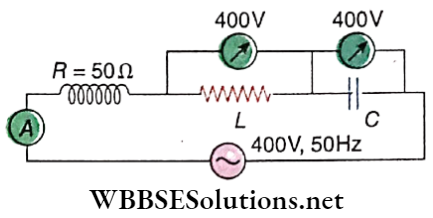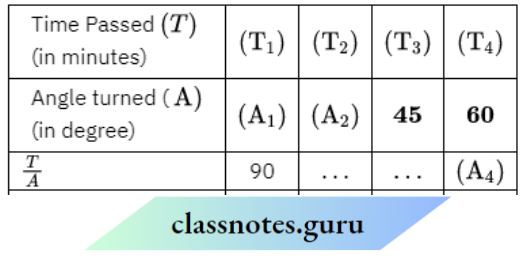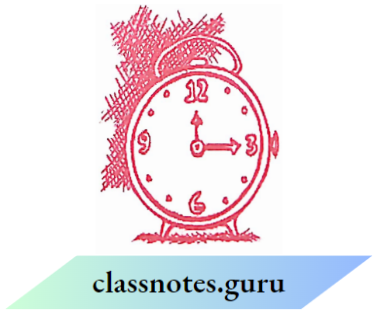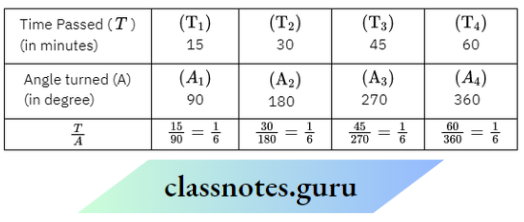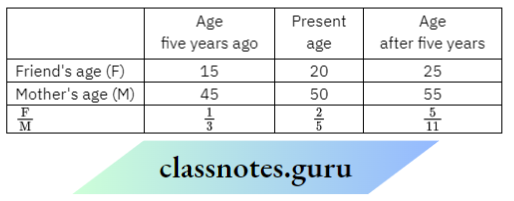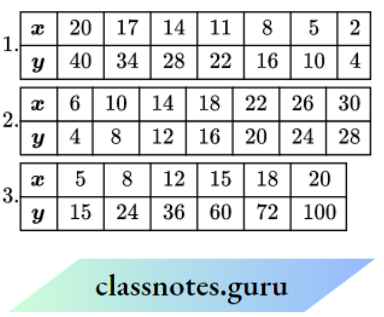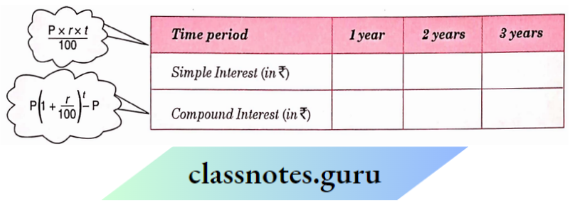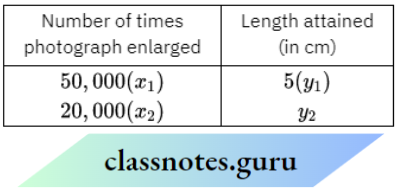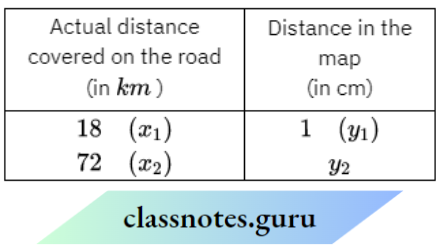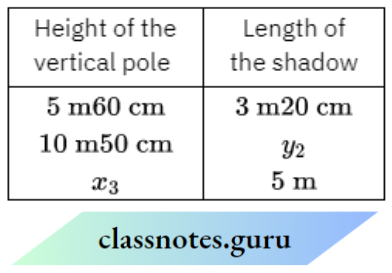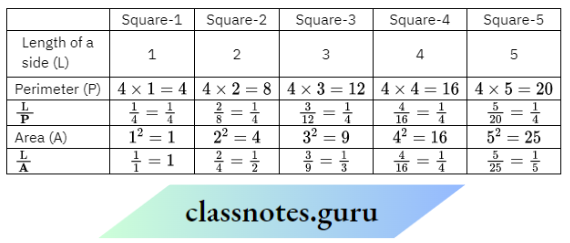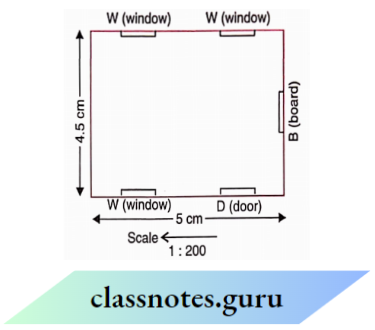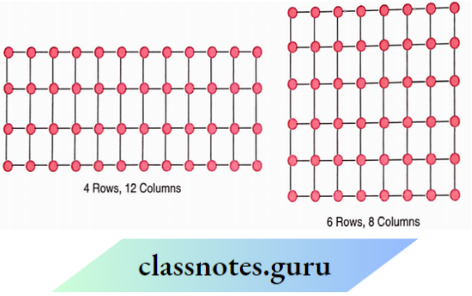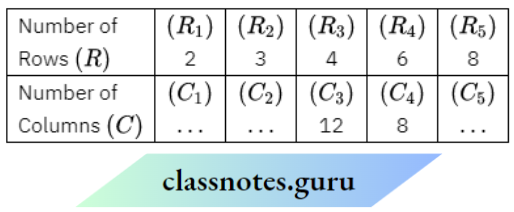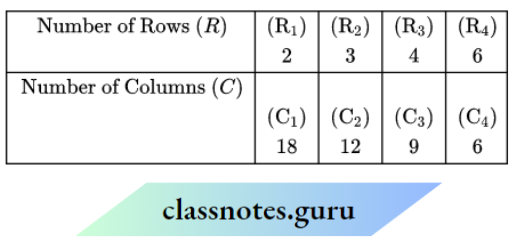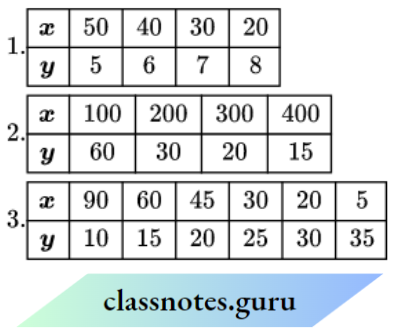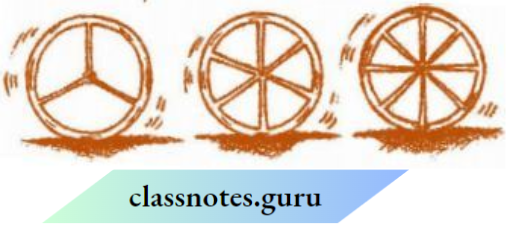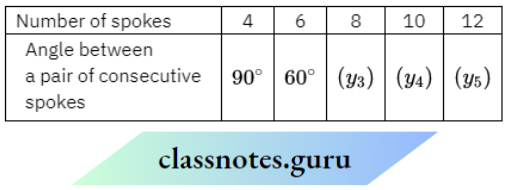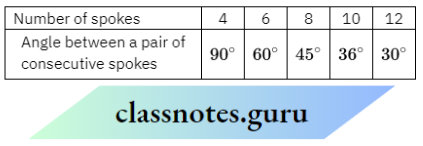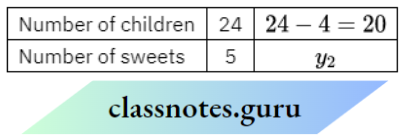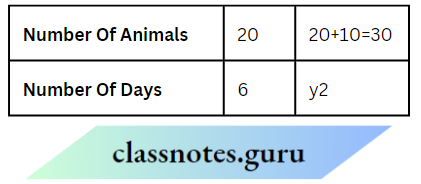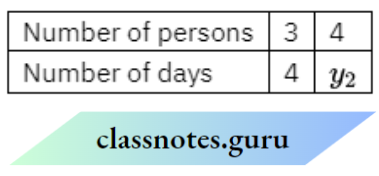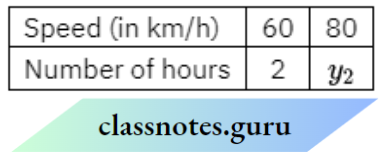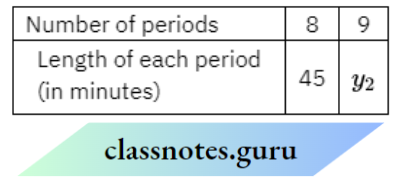Electrostatics
1. Electrostatics Introduction
The branch of physics that deals with the electric effect of static charge is called electrostatics.
2. Electric Charge
The charge of a material body or particle is the property (acquired or natural) due to which it produces and experiences electrical and magnetic effects. Some naturally charged particles are electrons, protons, α- α-particles, etc.
Charge is a derived physical quantity. Charge is measured in coulombs in S.Ι. units. In practice, we use mC (10-3C), μC (10-6C), nC(10-9C), etc.
C.G.S. unit of charge = electrostatic unit = esu.
1 coulomb = 3 × 109 esu of charge
Dimensional formula of charge = [MºLºT1Ι1]
Electrostatics Class 12 Notes
2.1 Electric Charges

It was observed that if two glass rods rubbed with wool or silk cloth are brought closer, they repel each other.
The two strands of wool or two pieces of silk cloth, with which the rods were rubbed, also repel each other. However, the glass rod and wool attracted each other. Similarly, two plastic rods rubbed with a cat’s fur repelled each other but attracted the fur. Careful studies by different scientists concluded that there were only two kinds of an entity called the electric charge.
We say that the bodies like glass or plastic rods, silk, fur, and pith balls are electrified. They acquire an electric charge on rubbing.
The experiments on pith balls suggested that there are two kinds of electrification, and we find that (1) like charges repel and (2) unlike charges attract each other
The charges were named as positive and negative by the American scientist Benjamin Franklin. By convention,
The charge on a glass rod or cat’s fur is called positive, and that on a plastic rod or silk is termed negative. If an object possesses an electric charge, it is said to be electrified or charged. When it has no charge, it is said to be neutral
2.2 Properties of Charge
Charge is a scalar quantity: It adds algebraically and represents the excess or deficiency of electrons.
A charge is of two types :
- Positive charge and
- Negative charge.
Charging a body implies the transfer of charge (electrons) from one body to another. A positively charged body means loss of electrons, i.e., deficiency of electrons. A negatively charged body means an excess of electrons. This also shows that the mass of a negatively charged body > the mass of a positively charged identical body.
A charge is conserved: In an isolated system, the total charge (sum of positive and negative) remains constant, whatever change takes place in that system.
A charge is quantized: A charge on anybody always exists in integral multiples of a fundamental unit of electric charge. This unit is equal to the magnitude of the charge on an electron (1e = 1.6 × 10-19 coulomb). So charge on anybody Q = ± ne, where n is an integer and e is the charge of the electron. Millikan’s oil drop experiment proved the quantization of charge or atomicity of charge
NEET Physics Electrostatics Notes
Note : Recently, the existence of particles of charge ±e\(\frac{1}{3} \text { and } \frac{2}{3}\) ±e has been postulated. These particles are called quarks but st, this is not considered as the quantum of charge because these are unstable (They have ve very short span of life).
Like point charges repel each other, while unlike point charges attract each other. (vi) Charge is always associated with mass, i.e., charge can not exist without mass though mass can exist without charge. The Particle as photons neneutrinoshich have no (rest) mass can never have a charge charge is relativistically invariant: This means that charge is independent the of frame of reference, i.e., the charge on a body does not change whatever be its speed. This property is worth mentioning as in contrast to charging, the mass of a body depends on its speed and increases with an increase in speed.
A charge at rest produces only an electric field around itself; a charge having uniform motion produces an electric as well as maa magnetic field around itself while a charge having accelerated motion emits electromagnetic radiation.
2.3 Charging of a body
A body can be charged by using) friction, (b) conduction, (c) induction, (d) thermionic ionization or thermionic emission, (e) photoelectric effect, and (f) field emission.
Charging by Friction: When a neutral body is rubbed against another neutral body, then some electrons are transferred from one body to another body, which can hold electrons tightly, draws some electrons, and the body that can not hold electrons tightly, loses electrons. The body that draws electrons becomes negatively charged, and the body that loses electrons becomes positively charged.

For example, Suppose a glass rod is rubbed with a silk cloth. As the silk can hold electrons more tightly and a glass rod can hold electrons less tightly (due to their chemical properties), some electrons will leave the glass rod and get transferred to the silk. So in the glass rod t, heir will be a deficiency of electrons, therefore it will become positively charged. In the silk there will be some extra electrons, so it will become negatively charged
Charging by conduction (flow): There are three types of material in nature
Conductor: Conductors are the materials in which the outermost electrons are very loosely bound, so they are free to move (flow). So in a conductor, there are a large number of free electrons.
Example: Metals like Cu, Ag, Fe, Al………….
Insulator or Dielectric or Nonconductor: Non-conductors are the materials in which outermost electrons are very tightly bound so they cannot move (flow). Hence in a non-conductor, there are no free electrons.
Examples are rubber, wood, etc, etc.
Semiconductor: Semiconductors are theories with free electrons, but in very less in numbers.

Now, learn how the charging is done by conduction. In this method, we take a charged conductor ‘A’ and an uncharged conductor ‘B’. When both are connected, some charge will flow from the body to the uncharged body. If both the conductors are identical and kept at a large distance, if connected, then the charge will be divided equally in both conductors; otherwise, they will flow till their electric potential becomes equal. A detailed study will be done in the first section of this chapter.
Class 12 Physics Chapter 5 Notes
Charging by Induction: To understand this, let’s have an introduction to induction.

We have studied that there are a lot of free electrons in the conductors. When a charge article +Q is brought near a neutral conductor. Due to the reaction of the +Q charge, many electrons (–ve charges) come closer and accumulate on the closer surface. On the other hand, a positive charge (deficiency of electrons) appears on the other surface. The flow of charge continues till the resultant force on the free electrons of the conductor becomes zero. This phenomenon is called induction, and the charges produced are called induced charges.
A body can be charged by induction in the following two ways :
Method 1 :
Step 1.
- Take an isolated neutral conductor.

Step 2.
- Bring a charged rod near it. Due to the charged rod, charges will be induced on the conductor.

Step 3.
- Connect another neutral conductor with it.
- Due to the attraction of the rod, some free electrons will move from the right conductor to the left conductor, and due to the deficiency of electrons positive charges
- Will appear on the right conductor, and on the left conductor, there will be an e excess of electrons due to transfer from the right conductor.

Step 4.
- Now, disconnect the connecting wire and remove the rod.

The first conductor will be negatively charged, and the second conductor will be positively charged.
Electrostatics Notes For NEET
Method 2:
Step 1.
- Take an isolated neutral conductor.

Step 2.
- Bring a charged rod near it. Due to the charged rod, charges will be induced on the conductor.

Step 3.
- Connect the conductor to the earth (this process is called grounding or earthing).
- Due to the attraction of the rod, some free electrons will move from the earth to the conductor, so in the conductor.
- There will be an excess of electrons due to transfer from the earth, so the net charge on the conductor will be negative.

Step 4.
- Now disconnect the connecting wire. The conductor becomes negatively charged.

Thermionic emission: When the metal is heated at a high temperature then some electrons of the metal are ejected and the metal becomes positively charged.

Photoelectric effect: When light of sufficiently high frequency is incident on the metal surface, some electrons gain energy from the light and come out of the metal surface, and the remaining metal becomes positively charged.

Field emission: When the electric field of large magnitude is applied near the metal surface then some electrons come out from the metal surface, and hence the metal gets positively charged.

Physics Chapter 5 Class 12 – Electrostatics
2.4 Gold Leaf Electroscope (GLE)
A simple apparatus to detect charge on a body is the gold-leaf electroscope
It consists of a vertical metal rod housed in a box, with two thin gold leaves attached to its bottom end. When a charged object touches the metal knob at the top of the rod, charge flows onto the leaves and they diverge.

Solved Examples
Example 1. If a charged body is placed near a neutral conductor, will it attract the conductor or repel it?
Solution :

If a charged body (+ve) is placed left side near a neutral conductor, (–ve) charge will induce at the left surface, and (+ve) charge will induce at the right surface.
- Due to the positively charged body, the -ve induced charge will feel attraction, and the +ve induced charge will feel repulsion.
- But as the -ve induced charge is nearer, so the attractive force will be greater than the repulsive force.
- So the net force on the conductor due to the positively charged body will be attractive. Similarly, we can prove this for the negatively charged bodies also.
- From the above example, we can conclude that. “A charged body can attract a neutral body.” If there is attraction between two bodies, then one of them may be neutral.
- But if there is repulsion between two bodies, both must be charged (similarly charged). So “repulsion is the sure test of electrification”.
Example 2. A positively charged body ‘A’ attracts a body ‘B,’ then the charge on body ‘B’ may be:
- Positive
- Negative
- Zero
- Can’t say
Solution: (2, 3)
Example 3. Five styrofoam balls, A, B, C, D, and E, are used in an experiment. Several experiments are performed on the balls, and the following observations are made :
- Ball A repels C and attracts B.
- Ball D attracts B and does not affect E.
- A negatively charged rod attracts both A and E.
For your information, an electrically neutral Styrofoam ball is very sensitive to charge induction and gets attracted considerably if placed near a charged body. What are the charges, if any, on each ball?
A B C D E
(1) + – + 0 +
(2) + – + + 0
(3) + – + 0 0
(4) – + – 0 0
Answer: 3
Solution:
From (1), as A repels C, both A and C must be charged similarly. Either both are +ve or both are -ve. As A also attracts B, so charge on B should be opposite to A or B may be an uncharged conductor.
From (2) As D does not affect E, both D and E should be uncharged, and as B attracts uncharged D, B must be charged and D must be on the uncharged conductor.
From (3) a –ve charged rod attracts the charged ball A, so A must be +ve, and from exp. (i) C must also be +ve and B must be ve.
CBSE Class 12 Physics Electrostatics Notes
Example 4. Charge conservation is always valid. Is it also true for mass?
Solution:
No, mass conservation is not always. In some nuclear reactions, some mass is lost and it is converted into energy.
Example 5. What are the differences between charging by induction and charging by conduction?
Solution:
The major differences between the two methods of charging are as follows :
In induction, two bodies are close to each other but do not touch each other while in conduction they touch each other. (or they are connected by a metallic wire)
In induction, the total charge of a body remains unchanged while in conduction it changes.
In induction, the induced charge is always opposite to that of the source charge while in conduction charge on two bodies finally is of the same nature.
Example 6. If a glass rod is rubbed with silk it acquires a positive charge because :
- Protons are added to it
- Protons are removed from it
- Electrons are added to it
- Electrons are removed from it.
Answer: 4. Electrons are removed from it.
Example 7. How can you charge a metal sphere positively without touching it?
Solution :
Figure (a) shows an uncharged metallic sphere on an insulating stand. Bring a negatively charged rod close to the metallic sphere, as shown in Fig. (b). As the rod is brought close to the sphere, the free electrons in the sphere move away due to repulsion and start piling up at the farther end. The near end becomes positively charged due to a deficit of electrons. This process of charge distribution stops when the net force on the free electrons inside the metal is zero.
Connect the sphere to the ground by a conducting wire. The electrons will flow to the ground while the positive charges at the near end will remain held there due to the attractive force of the negative charges on the rod, as shown in Fig. (c).
Disconnect the sphere from the ground. The positive charge continues to be held at the near end of Fig.(d) Remove the electrified rod. The positive charge will spread uniformly over the sphere as shown in Fig. (e).

Example 8. If 109 electrons move out of one body to another body every second, how much time is required to get a total charge of 1 C on the other body?
Solution:
In one second 109 electrons move out of the body. Therefore the charge given out in one second is 1.6 × 10-19 × 109 C = 1.6 × 10-10 C.
The time required to accumulate a charge of 1 C can then be estimated to be
⇒ \(\frac{1 \mathrm{C}}{1.6 \times 10^{-10} \mathrm{C} / \mathrm{s}}=6.25 \times 10^9 \mathrm{~s}=\frac{6.25 \times 10^9}{365 \times 24 \times 3600} \text { years }=198 \text { years. }\)
Thus to collect a charge of one coulomb, from a body from which 109 electrons move out every second, we will need approximately 200 years. One coulomb is, therefore, a very large unit for many practical purposes.
Electrostatics Handwritten Notes For Neet
Example 9. How much positive and negative charge is there in a cup of water?
Solution :
Let us assume that the mass of one cup of water is 250 g.
The molecular mass of water is 18g.
One mole(= 6.02 × 1023 molecules) of water is 18 g. Therefore the number of molecules in one 9
cup of water is \(\frac{250 \times 10^9}{18} \times 6.02 \times 10^{23}\)
Each molecule of water contains two hydrogen atoms and one oxygen atom, i.e., 10 electrons and 10 protons. Hence the total positive and total negative charge has the same magnitude. It is equal to \(\frac{250 \times 10^9}{18} \times 6.02 \times 10^{23} \times 10 \times 1.6 \times 10^{-19} \mathrm{C}=1.34 \times 10^7 \mathrm{C} \text {. }\)
Example 10. Which is bigger, a coulomb or charge on an electron? How many electronic charges form one coulomb of charge?
Solutions :
A coulomb of charge is bigger than the charge on an electron.
The magnitude of the charge on one electron, e = 1.6 ×10-19 coulomb
Number of electronic charge in one coulomb, \(n=\frac{q}{e}=\frac{1}{1.6 \times 10^{-19}}=0.625 \times 10^{19}\)
Example 11. Assume that each atom in a copper wire contributes one free electron. Estimate the number of free electrons in a copper wire having a mass of 6.4 g (take the atomic weight of copper to be 64g/mol).
Solutions :
Number of atoms in 64 g of copper = 6.023 × 1023
Number of atoms in 6.4 g of copper = \(\frac{6.023 \times 10^{23}}{64} \times 6.4=6.023 \times 10^{22}\)
As each atom contributes one free electron, therefore, number of free electrons in copper wire = 6.023 × 1022.
3. Coulomb’s Law (Inverse Square Law)
Based on experiments Coulomb established the following law known as Coulomb’s law. The magnitude of the electrostatic force between two point charges is directly proportional to the product of charges and inversely proportional to the square of the distance between them.
i.e. F ∝ q1q2 and F ∝\(\frac{1}{r^2} \quad \Rightarrow \quad F \propto \frac{q_1 q_2}{r^2} \quad \Rightarrow \quad F=\frac{K q_1 q_2}{r^2}\)
Important points regarding Coulomb’s law :
- It is applicable only for point charges.
- The constant of proportionality K in SI units in a vacuum is expressed as \(\frac{1}{4 \pi \varepsilon_0}\)and in any other medium expressed as \(\frac{1}{4 \pi \varepsilon}\) If charges are dipped in a medium then electrostatic force on one 230
- Charge is \(\frac{1}{4 \pi \varepsilon_0 \varepsilon_r} \frac{q_1 q_2}{r^2} .\) ε0 and ε are called the permittivity of the vacuum and absolute permittivity of the medium respectively. The ratio ε/ε0 = εr is called the relative permittivity of the medium, which is a dimensionless quantity.
- The value of relative permittivity εris constant for medium and can have values between 1 to ∞. For vacuum, by definition, it is equal to 1. For air, it is nearly equal to 1 and may be taken to be equal to 1 for calculations. For metals, the value of εris ∞ and for water is 81. The material in which more charge can induce εr will be higher.
- The value of \(\frac{1}{4 \pi \varepsilon_0}\) = 9 × 109 Nm2C–2 ⇒ ε0= 8.855 × 10-12C2/Nm2. 0
- Dimensional formula of ε is M-1 L-3 T4 A2
- The force acting on one point charge due to the other point charge is always along the line joining these two charges. It is equal in magnitude and opposite in direction on two charges, irrespective of the medium, in which they lie.
- The force is conservative i.e., work done by electrostatic force in moving a point charge along a close loop of any shape is zero.
- Since the force is a central force, in the absence of any other external force, the angular momentum of one particle w.r.t. the other particle (in a two-particle system) is conserved,
- Coulomb Low In Vector Form
Let us consider q1 and q2are placed at positions r1 = x1iˆ + y1jˆ + z1kˆand r = x2 i + y2j + z2 k respectively. If we want to calculate coulomb force on q2 then q1 will be considered as a source charge and q2 will be considered as a test charge.

⇒ \(\vec{F}=\frac{\mathrm{kq}_1 q_2}{|\overrightarrow{\mathrm{r}}|^3} \overrightarrow{\mathrm{r}} \text { where } \overrightarrow{\mathrm{r}}\)= position vector of test charge–position vector source charge.
(r= position vector of test charge w.r.t. source charge)
- When we use this formula in vector form then we have to put the value of charges with their sign.
- If the force F12 on charge q1 due to charge q2, and F21 is force on charge q2due to charge q1 then \(\overrightarrow{\mathrm{F}}_{12}=\frac{1}{4 \pi \varepsilon_0} \frac{\mathrm{q}_1 \mathrm{q}_2}{\mathrm{r}_{21}^2} \hat{r}_{12}=-\overrightarrow{\mathrm{F}}_{21}\)
Electrostatics Revision Notes For NEET
Example 12. Find out the electrostatic force between two point charges placed in the air (each of +1 C) if they are separated by 1m.
Solution :
⇒ \(F_e=\frac{k q_1 q_2}{r^2}=\frac{9 \times 10^9 \times 1 \times 1}{1^2}=9 \times 10^9 \mathrm{~N}\)
From the above result, we can say that the 1 C charge is too large to realize. In nature, the charge is usually of the order of μC
Example 13. Two particles having charges q1 and q2 when kept at a certain distance, exert a force F on each other. If the distance between the two particles is reduced to half and the charge on each particle is doubled then what will be the force between the particles :
Solution :
⇒ \(F=\frac{k q_1 q_2}{r^2}\)
If q’1= 2q1, q’2= 2q2 r’ = \(\frac{r}{2}\)
then F’ = \(F^{\prime}=\frac{k q_1^{\prime} q_2^{\prime}}{r^{\prime 2}}=\frac{k\left(2 q_1\right)\left(2 q_2\right)}{\left(\frac{r}{2}\right)^2} \)
F’ = \(\quad F^{\prime}=\frac{16 k q_1 q_2}{r^2}\)
Example 14. A particle of mass m carrying charge q1 revolves around a fixed charge –q2 in a circular path of radius r. Calculate the period of revolution and its speed.
Solution :
⇒ \(\frac{1}{4 \pi \varepsilon_0} \frac{q_1 q_2}{r^2}=m r \omega^2=\frac{4 \pi^2 m r}{T^2}, \quad T^2=\frac{\left(4 \pi \varepsilon_0\right) r^2\left(4 \pi^2 m r\right)}{q_1 q_2} \quad \text { or } \quad T=4 \pi r \sqrt{\frac{\varepsilon_0 m r}{q_1 q_2}}\)
and also we can say that \(\frac{q_1 q_2}{4 \pi \varepsilon_0 r^2}=\frac{m v^2}{r} \quad \Rightarrow \quad v=\sqrt{\frac{q_1 q_2}{4 \pi \varepsilon_0 m r}}\)
Example 15. A point charge qA= + 100 µc is placed at point A (1, 0, 2) m, and another point charge qB= +200µc is placed at point B (4, 4, 2) m. Find :
- The magnitude of the Electrostatic interaction force acting between them
- FA(force on A due to B) and FB(force on B due to A) in vector form
Solution :

Value of F : \(|F|=\frac{k q_A q_B}{r^2}=\frac{\left(9 \times 10^9\right)\left(100 \times 10^{-6}\right)\left(200 \times 10^{-6}\right)}{\sqrt{(4-1)^2+(4-0)^2+(2-2)^2}}=7.2 \mathrm{~N}\)
Force on B \(\vec{F}_B=\frac{k q_A q_B}{|\vec{r}|^3} \vec{r}=\frac{\left(9 \times 10^9\right)\left(100 \times 10^{-6}\right)\left(200 \times 10^{-6}\right)}{\sqrt{(4-1)^2+(4-0)^2+(2-2)^2}}[(4-1) \hat{\mathrm{i}}+(4-0) \hat{\mathrm{j}}+(2-2) \hat{k}]\)
⇒ \(7.2\left(\frac{3}{5} \hat{i}+\frac{4}{5} \hat{j}\right) N\)
Similarly \(\vec{F}_A=7.2\left(-\frac{3}{5} \hat{i}-\frac{4}{5} \hat{j}\right) \mathrm{N}\)
Action(FA) and Reaction (FB) are equal but in opposite directions.
Example 16. A charged metallic sphere A is suspended by a nylon thread. Another charged metallic sphere B held by an insulating handle is brought close to A such that the distance between their centers is 10 cm, as shown in Fig. (a). The resulting repulsion of A is noted (for example, by shining a beam of light and measuring the deflection of its shadow on a screen). Spheres A and B are touched by uncharged spheres C and D, respectively, as shown in Fig. (b). C and D are then removed, and B is brought closer to A distance of 5.0 cm between their centers, as shown in Fig. (c). What is the expected repulsion of A based on Coulomb’s law? Spheres A and C and spheres B and D have identical sizes. Ignore the sizes of A and B in comparison to the separation between their centers.

Solution :
Let the original charge on sphere A be q and that on B be q’. At a distance r between their centers, the magnitude of the electrostatic force on each is given by
⇒ \(F=\frac{1}{4 \pi \varepsilon_0} \frac{q^{\prime}}{\mathrm{r}^2}\)
Neglecting the sizes of spheres A and B in comparison to r. When an identical but uncharged sphere C touches A, the charges redistribute on A and C, and, by symmetry, each sphere carries a charge q/2. Similarly, after D touches B, the redistributed charge on each is q’/2. Now, if the separation between A and B is halved, the magnitude of the electrostatic force on each is
⇒ \(\mathrm{F}^{\prime}=\frac{1}{4 \pi \varepsilon_0} \frac{(\mathrm{q} / 2)\left(\mathrm{q}^{\prime} / 2\right)}{(\mathrm{r} / 2)^2}=\frac{1}{4 \pi \varepsilon_0} \frac{\left(\mathrm{qq}^{\prime}\right)}{\mathrm{r}^2}=F\)
Thus the electrostatic force on A, due to B, remains unaltered.
Electrostatics Class 12 Notes
4. Principle Of Superposition
The electrostatic force is a two-body interaction i.e. electrical force

between two point charges are independent of the presence or absence of other charges and so the principle of superposition is valid i.e. force on the charged particle due to several point charges is the resultant of forces due to individual point charges.
Consider that n point charges q1, q2, q3, …. are discretely distributed in space. The charges are interacting with each other. Let us find the total force on the charge, say due to all other remaining charges. If the charge q2, q3, …. qnexert forces\(\overrightarrow{\mathrm{F}}_{12}, \overrightarrow{\mathrm{F}}_{13}, \ldots . \overrightarrow{\mathrm{F}}_{1 \mathrm{n}}\)on the charge q1, then according to principle of superposition, the total force on charge q1is given by \(\overrightarrow{\mathrm{F}}_1=\overrightarrow{\mathrm{F}}_{12}+\overrightarrow{\mathrm{F}}_{13}+\ldots \ldots \overrightarrow{\mathrm{F}}_{1 \mathrm{n}}\)
Solved Examples
Example 17. Two point charges of charge value Q and q are placed at a distance of x and x/2 respectively from a third charge of charge value 4q, all charges being in the same straight line. Calculate the magnitude and nature of charge Q, such that the net force experienced by the charge q is zero.
Solution :
Suppose that the charge 4q is located at point A. The charges Q and q are placed at points B and C, such that AB = x and AC = x/2. Also, all the charges lie in the same straight line. We assume that the charges of 4q and q are of the same nature, a say positive.
Then, force on the charge q due to 4q,
⇒ \(\mathrm{F}_{\mathrm{A}}=\frac{1}{4 \pi \varepsilon_0} \cdot \frac{4 \mathrm{q} \cdot \mathrm{q}}{(\mathrm{x} / 2)^2}\)

The net force experienced by charge q will be zero only if the charge Q exerts force on the charge q equal and opposite to that exerted by the charge 4q. Thus, the charge Q should exert force FBon charge q equal to FA(in magnitude) and along CA. For this, charge Q has to be positive (i.e. of the nature same as that of 4q or q).
Now, force on the charge q due to charge Q
FB= \(\mathrm{F}_{\mathrm{B}}=\frac{1}{4 \pi \varepsilon_0} \cdot \frac{\mathrm{Q} . \mathrm{q}}{(\mathrm{BC})^2}\)
FB=\(\mathrm{F}_{\mathrm{B}}=\frac{1}{4 \pi \varepsilon_0} \cdot \frac{\mathrm{Q} . \mathrm{q}}{(\mathrm{x} / 2)^2}\) (along CA)
For net force on the charge q to be zero, FB= FA
⇒ \(\frac{1}{4 \pi \varepsilon_0} \cdot \frac{Q . q}{(x / 2)^2}=\frac{1}{4 \pi \varepsilon_0} \cdot \frac{4 q \cdot q}{(x / 2)^2}=Q=4 q\)
Example 18. Consider three point charges each having charge q at the vertices of an equilateral triangle of side l. What is the force on a charge Q (with the same sign as q) placed at the centroid of the triangle, as shown in the figure?

Solution :
In the given equilateral triangle ABC of sides of length l, if we draw a perpendicular AD to the side BC, AD = AC cos 30º = ( 3 / 2) l and the distance AO of the centroid O from A is (2/3) AD = Thus, (1/ 3)l. By symmetry AO = BO = CO.
Force \(\overrightarrow{\mathrm{F}}_1\) on Q due to charge q at A = \(\frac{3}{4 \pi \varepsilon_0} \frac{\mathrm{Qq}}{\ell^2}\) along AO
Force \(\overrightarrow{\mathrm{F}}_2\)on Q due to charge q at B = \(\frac{3}{4 \pi \varepsilon_0} \frac{\mathrm{Qq}}{\ell^2}\) along BO
Force \(\overrightarrow{\mathrm{F}}_3\)on Q due to charge q at C = \(\frac{3}{4 \pi \varepsilon_0} \frac{\mathrm{Qq}}{\ell^2}\)along CO
The resultant of forces \(\overrightarrow{\mathrm{F}}_2 and \overrightarrow{\mathrm{F}}_3\) is \(\frac{3}{4 \pi \varepsilon_0} \frac{\mathrm{Qq}}{\ell^2}\) along OA, by the parallelogram law. Therefore, the total force on Q = \(\frac{3}{4 \pi \varepsilon_0} \frac{\mathrm{Qq}}{\ell^2}\) = 0, where rˆ is the unit vector along OA.
It is clear also by symmetry that the three forces will sum to zero. Suppose that the resultant force was non-zero but in some direction. Consider what would happen if the system was rotated through 60º about O.
NEET Physics Electrostatics Notes
Example 19. Consider the charges q, q, and –q placed at the vertices of an equilateral triangle of side l. Calculate the force on each charge.?
Solution :

The forces acting on charge q at A due to charges q at B and –q at C are \(\overrightarrow{\mathrm{F}}_{\mathrm{AB}}\) along BA and \(\overrightarrow{\mathrm{F}}_{\mathrm{Ac}}\) along AC respectively as shown in Fig.
The force of attraction or repulsion for each pair of charges has the same magnitude 2
⇒ \(\mathrm{F}=\frac{\mathrm{q}^2}{4 \pi \varepsilon_0 \ell^2}\)
⇒ \(\left|F_A\right|=\left|F_B\right|=F\)
⇒ \(\left|F_C\right|=\sqrt{3} F\)

⇒ \(\overrightarrow{\mathrm{F}}_{\mathrm{A}}+\overrightarrow{\mathrm{F}}_{\mathrm{B}}+\overrightarrow{\mathrm{F}}_{\mathrm{C}}=0 .\)
It is interesting to see that the sum of the forces on three charges is zero.
Example 20. Two pith-balls each of mass weighing 10-4kg are suspended from the same point using silk threads 0.5 m long. On charging the pith balls equally, they are found to repel each other to a distance of 0.6 m. Calculate the charge on each ball. (g = 10m/s2)
Solution :
Consider two pith balls A and B each having charge q and mass 10-13 kg. When the pith balls are suspended from point S by two threads each 0.5 m long, they repel each other to the distance AB = 0.2 m as shown in Fig.

Each of the two pith-balls is in equilibrium under the action of the following three forces :
- The electrostatic repulsive force F.
- The weight acts vertically downwards.
- The tension T in the string is directed towards point S. The three forces mg, F, and T can be represented by the therefore, according to the triangle law of forces,
⇒ \(\frac{F}{O A}=\frac{m g}{S O}=\frac{T}{A S}\)…….(1)
Here, \(\mathrm{F}=\frac{1}{4 \pi \varepsilon_0} \cdot \frac{\mathrm{q}^2}{(\mathrm{AB})^2}=9 \times 10^9 \times \frac{\mathrm{q}^2}{(0.6)^2} \mathrm{~N}\)
mg = 10-4 × 10 = 10-3 N
From the equation (i), we have
F = mg × \(\frac{O A}{S O} \quad \text { or } \quad 9 \times 10^9 \times \frac{q^2}{(0.6)^2}=10^{-3} \times \frac{0.3}{\sqrt{(0.5)^2-(0.3)^2}} \text { or } \quad q=\sqrt{3} \times 10^{-6} \mathrm{C}\)
Example 21 Three equal point charges of charge +qise moving along a circle of radius R and a point charge –2q is also placed at the center of the circle as (shown in the figure), if charges are revolving with constant and same speed then calculate speed.

Solution :

F2– 2F1cos 30 = \(\frac{m v^2}{R} \Rightarrow \frac{K(q)(2 q)}{R^2}-\frac{2\left(K q^2\right)}{(\sqrt{3} R)^2} \cos 30=\frac{m v^2}{R} \Rightarrow v=\sqrt{\frac{k q^2}{R m}}\left[2-\frac{1}{\sqrt{3}}\right]\)
Example 22 Two equally charged identical small metallic spheres A and B repel each other with a force 2 × 10-5N when placed in air (neglect gravitation attraction). Another identical uncharged sphere C is touched to B and then placed at the midpoint of the line joining A and B. What is the net electrostatic force on C?
Solution :
Let initially the charge on each sphere be q and separation between their centers be r; then according to a given problem.
⇒ \(\mathrm{F}=\frac{1}{4 \pi \varepsilon_0} \frac{\mathrm{q} \times \mathrm{q}}{\mathrm{r}^2}=2 \times 10^{-5} \mathrm{~N}\)

When sphere C touches B, the charge of B, q will distribute equally on B and C as spheres are identical conductors, i.e., now charges on spheres;
qB= qC= (q/2)
So sphere C will experience a force

⇒ \(\mathrm{F}_{\mathrm{CA}}=\frac{1}{4 \pi \varepsilon_0} \frac{\mathrm{q}(\mathrm{q} / 2)}{(\mathrm{r} / 2)^2}=2 \mathrm{~F} \text { along } \overrightarrow{\mathrm{AB}}\) due to charge on A
and,\(\mathrm{F}_{\mathrm{CB}}=\frac{1}{4 \pi \varepsilon_0} \frac{(\mathrm{q} / 2)(\mathrm{q} / 2)}{(\mathrm{r} / 2)^2}=\mathrm{F} \text { along } \overrightarrow{\mathrm{BA}}\) due to charge on B
So the net force FCon C due to charges on A and B,
FC= FCA – FCB = 2F – F = 2 × 10–5 N along AB.
Example 23 Five point charges, each of value q are placed on five vertices of a regular hexagon of side L. What is the magnitude of the force on a point charge of value – q coulomb placed at the center of the hexagon?
Solution :
Method: 1
If there had been a sixth charge +q at the remaining vertex of hexagon force due to all the six charges on –q at O would be zero (as the forces due to individual charges will balance each other), i.e.,
⇒ \(\overrightarrow{F_R}=0\)
Now if \(\vec{f}\) is the force due to the sixth charge and \(\vec{f}\) due to the remaining five charges.
⇒ \(\vec{F}+\vec{f}=0 \quad \text { i.e. } \quad \vec{F}=-\vec{f} \text { or, } \quad|F|=|f|=\frac{1}{4 \pi \varepsilon_0} \frac{q \times q}{L^2}=\frac{1}{4 \pi \varepsilon_0} \frac{q^2}{L^2}\)

⇒ \(\vec{F}_{\text {Net }}=\vec{F}_{\mathrm{CO}}=\frac{1}{4 \pi \varepsilon_0} \frac{\mathrm{q}^2}{\mathrm{~L}^2} \text { along } \mathrm{CO}\)
Method: 2
In the diagram we can see that force due to charges A and D are opposite to each other

Similarly
⇒ \(\vec{F}_{D O}+\vec{F}_{A O}=0\)
⇒ \(\vec{F}_{B O}+\vec{F}_{E O}=0\)
Using (1) and (2)\(\vec{F}_{\text {Net }}=\overrightarrow{\mathrm{F}}_{\mathrm{CO}}=\frac{1}{4 \pi \varepsilon_0} \frac{\mathrm{q}^2}{\mathrm{~L}^2} \text { along } \mathrm{CO} \text {. }\) along CO. 2
Note: The total charge of A rod cannot be considered to be placed at the center of the rod as we do in mechanics for mass in many problems.
Note: If a >> l then F =\(\frac{K Q q}{a^2}\) behavior of the rod is just like a point charge.
Class 12 Physics Chapter 5 Notes
5. Electrostatic Equilibrium
The point where the resultant force on a charged particle becomes zero is called the equilibrium position.
5.1 Stable Equilibrium: A charge is initially in an equilibrium position and is displaced by a small distance. If the charge tries to return to the same equilibrium position then this equilibrium is called the position of stable equilibrium.
5.2 Unstable Equilibrium: If the charge is displaced by a small distance from its equilibrium position and the charge does not tend to return to the same equilibrium position. Instead, it goes away from the equilibrium position.
5.3 Neutral Equilibrium: If the charge is displaced by a small distance and it is still in equilibrium condition then it is called neutral equilibrium.
Solved Examples
Example 24 Two equal positive point charges ‘Q’ are fixed at points B(a, 0) and A(–a, 0). Another test charge q0 is also placed at O(0, 0). Show that the equilibrium at ‘O’ is
- Stable for displacement along the X-axis.
- Unstable for displacement along the Y-axis.
Solution :

Initially\(\overrightarrow{\mathrm{F}}_{\mathrm{AO}}+\overrightarrow{\mathrm{F}}_{\mathrm{BO}}=0 \Rightarrow\left|\overrightarrow{\mathrm{F}}_{\mathrm{AO}}\right|=\left|\overrightarrow{\mathrm{F}}_{\mathrm{BO}}\right|=\frac{K Q q_0}{\mathrm{a}^2}\)
When the charge is slightly shifted towards the + x-axis by a small distance Δx, then.

⇒ \(\left|\vec{F}_{\mathrm{AO}}\right|<\left|\dot{\vec{F}}_{\mathrm{BO}}\right|\)
Therefore the particle will move toward the origin (its original position) hence the equilibrium is stable.
When the charge is shifted along the axis

After resolving components net force will be along the y-axis so the particle will not return to its original position so it is an unstable equilibrium. Finally, the charge will move to infinity.
Example 25. Two point charges of charge q1 and q2(both of the same sign) and each of mass m are placed such that gravitation attraction between them balances the electrostatic repulsion. Are they in stable equilibrium? If not then what is the nature of equilibrium?
Solution :
In given example :
⇒ \(\frac{\mathrm{Kq}_1 \mathrm{q}_2}{\mathrm{r}^2}=\frac{\mathrm{Gm}^2}{\mathrm{r}^2}\)
We can see that irrespective of the distance between them charges will remain in equilibrium. If now distance is increased or decreased then there is no effect on their equilibrium. Therefore it is a neutral equilibrium.
Example 26. A particle of mass m and charge q is located midway between two fixed charged particles each having a charge q and a distance 2l apart. Prove that the motion of the particle will be SHM if it is displaced slightly along the line connecting them and released. Also, find its time.
Solution :
Let the charge q at the mid-point the displaced slightly to the left.
The force on the displaced charge q due to charge q at A,
F1=\(\frac{1}{4 \pi \varepsilon_0} \frac{\mathrm{q}^2}{(\ell+\mathrm{x})^2}\)

The force on the displaced charge q due to charge at B,
F2= \(\frac{1}{4 \pi \varepsilon_0} \frac{q^2}{(\ell-x)^2}\)
Net restoring force on the displaced charge q.
F = F2– F1or F = F2= \(\frac{1}{4 \pi \varepsilon_0} \frac{\mathrm{q}^2}{(\ell-\mathrm{x})^2}-\frac{1}{4 \pi \varepsilon_0} \frac{\mathrm{q}^2}{(\ell+\mathrm{x})^2}\)
or F = \(\mathrm{F}=\frac{\mathrm{q}^2}{4 \pi \varepsilon_0}\left[\frac{1}{(\ell-\mathrm{x})^2}-\frac{1}{(\ell+\mathrm{x})^2}\right]=\frac{\mathrm{q}^2}{4 \pi \varepsilon_0} \frac{4 \ell \mathrm{x}}{\left(\ell^2-\mathrm{x}^2\right)^2}\)
Since l >> x, ∴ F = \(\frac{q^2 \ell x}{\pi \varepsilon_0 \ell^4} \text { or } F=\frac{q^2 x}{\pi \varepsilon_0 \ell^3}\)
We see that F ∝ x and it is opposite to the direction of displacement. Therefore, the motion is
SHM. T =\(\mathrm{T}=2 \pi \sqrt{\frac{\mathrm{m}}{\mathrm{k}}} \text {, here } \mathrm{k}=\frac{\mathrm{q}^2}{\pi \epsilon_0 \ell^3}=2 \pi \sqrt{\frac{\mathrm{m} \pi \epsilon_0 \ell^3}{\mathrm{q}^2}}\)
Example 27. Two identical charged spheres are suspended by strings of equal length. Each string makes an angle θ with the vertical. When suspended in a liquid of density σ = 0.8 gm/cc, the angle remains the same. What is the dielectric constant of the liquid? (The density of the material of the sphere is ρ = 1.6 gm/cc.)
Solution :
Initially, as the forces acting on each ball are tension T, weight mg, and electric force F, for its equilibrium along vertically,
T cos θ = mg …(1)
and along horizontal
T sin θ = F …(2)

Dividing Eqn. (2) by (1), we have
tan θ = Fmg… (3)
When the balls are suspended in a liquid of density σ and dielectric constant K, the electric force will become (1/K) times, i.e., F’ = (F/K) while weight
mg’ = mg – FB= mg – Vσg [as FB= Vσg, where σ is the density of the material of the sphere]
i.e., mg’ = mg \(\) So for equilibrium of ball,
tan θ’ = \(\frac{F^{\prime}}{m g^{\prime}}=\frac{F}{K m g[1-(\sigma / \rho)]}\)… (4)
According to the given information θ’ = θ; so from equations (4) and (3), we have
K = \(\frac{\rho}{(\rho-\sigma)}=\frac{1.6}{(1.6-0.8)}=2\)
6. Electric Field
The electric field is the region around a charged particle or charged body in which if another charge is placed, it experiences electrostatic force.
6.1 Electric field intensity
E: Electric field intensity at a point is equal to the electrostatic force experienced by a unit positive point charge both in magnitude and direction.
If a test charge q0is placed at a point in an electric field and experiences a force \(\overrightarrow{\mathrm{F}}\) due to some charges (called source charges), the electric field intensity at that point due to source charges is given
⇒ \(\overrightarrow{\mathrm{E}}=\frac{\overrightarrow{\mathrm{F}}}{\mathrm{q}_0} \text {; }\)
If the \(\overrightarrow{\mathrm{E}}\)is to be determined practically then the test charge q0 should be small otherwise it will affect the charge distribution on the source which is producing the electric field and hence modify the quantity which is measured.
Electrostatics Notes For NEET
Example 28. A positively charged ball hangs from a long silk thread. We wish to measure E at point P in the same horizontal plane as that of the hanging charge. To do so, we put a positive test charge q0 at the point and measure F/q0. Will F/q0 be less than, equal to, or greater than E at the point in question?
Solution :
When we try to measure the electric field at point P then after placing the test charge at P it repels the source charge (suspended charge) and the measured value of the electric field
Emeasured =\(\frac{F}{q_0}\) will be less than the actual value Eact that we wanted to measure.

6.2 Properties of electric field intensity E:
It is a vector quantity. Its direction is the same as the force experienced by a positive charge.
The direction of the electric field due to the positive charge is always away from it while due to the negative charge is always towards it.
Its S.Ι. unit is Newton/Coulomb.
Its dimensional formula is [MLT-3A-1]
The electric force on a charge q placed in a region of the electric field at a point where the electric field intensity is Eis given by \(\overrightarrow{\mathrm{F}}=\mathrm{q} \overrightarrow{\mathrm{E}} \text {. }\).
The electric force on the point charge is in the same direction as the electric field on a positive charge and in the opposite direction on a negative charge.
It obeys the superposition principle, that is, the field intensity at a point due to a system of charges is a vector sum of the field intensities due to individual point charges.
E = E1 + E2 + E3 + …….
It is produced by source charges. The electric field will be a fixed value at a point unless we change the distribution of source charges.
6.3 Electric field due to a point charge :
Consider that a point charge +q is placed at the origin O of the coordinate frame. Let P be the point,
where the electric field due to the point charge +q is to be determined. Let \(\overline{\mathrm{OP}}=\overrightarrow{\mathrm{r}}\) the position vector of the point P.

To find the electric field at point P, place a vanishingly small positive test charge q0at point P. According to Coulomb’s law, force on the test charge due to charge q is given by :
⇒ \(\overrightarrow{\mathrm{F}}=\frac{1}{4 \pi \varepsilon_0} \cdot \frac{\mathrm{qq}}{\mathrm{r}_0} \hat{\mathrm{r}}\)
where rˆis unit vector along OP. If \(\) is the electric field at point P, then
⇒ \(\vec{E}=\frac{\vec{F}}{q_0}=\left(\frac{1}{q_0} \cdot \frac{1}{4 \pi \varepsilon_0} \cdot \frac{q q_0}{r^2} \hat{r}\right) \quad \text { or } \quad \vec{E}=\frac{1}{4 \pi \varepsilon_0} \cdot \frac{q}{r^2} \hat{r}=\frac{1}{4 \pi \varepsilon_0} \cdot \frac{q}{r^3} \vec{r}\)
The magnitude of the electric field at point P is given by
⇒ \(E=\frac{1}{4 \pi \varepsilon_0} \cdot \frac{q}{r^2}\)
Solved Examples
Example 29. The electrostatic force experienced by –3μC charge placed at point ‘P’ due to a system ‘S’ of fixed point charges as shown in the figure is \(\overrightarrow{\mathrm{F}}=(2 \hat{1} \hat{i}+9 \hat{\mathbf{j}}) \mu \mathrm{N}.\)

- Find out electric field intensity at point P due to S.
- If now 2μC charge is placed and –3 μC is removed at point P then the force experienced by it will be.
Solution :
⇒ \(\vec{F}=q \vec{E} \quad \Rightarrow \quad(21 \hat{i}+9 \hat{j}) \mu N=-3 \mu C(\vec{E})\)
⇒ \(\vec{E}=-7 \hat{i}-3 \hat{j} \frac{\mu \mathrm{N}}{C}\)
Since the source charges are not disturbed the electric field intensity at ‘P’ will remain the same.
⇒ \(\vec{F}_{2 \mu C}=+2(\vec{E})=2(-7 \hat{i}-3 \hat{j})=-14 \hat{i}-6 \hat{j} \mu N\)
Example 30. Calculate the electric field intensity which would be just sufficient to balance the weight of a particle of charge –10 μc and mass 10 mg. (take g = 10 ms2)
Solution :
As the force on a charge q in an electric field \( \overrightarrow{\mathrm{E}}\) is
⇒ \(\overrightarrow{\mathrm{F}}_{\mathrm{q}}=\mathrm{q} \overrightarrow{\mathrm{E}}\)
So according to the given problem Fe

⇒ \(\left|\vec{F}_{\mathrm{q}}\right|=|\vec{W}| \quad \text { i.e., } \quad|\mathrm{q}| E=m g\)
⇒ \(E=\frac{\mathrm{mg}}{|\mathrm{q}|}=10 \mathrm{~N} / \mathrm{C} .\) in the downward direction.
List of formulas for Electric Field Intensity due to various types of charge distribution :

Electric Field Due To Point Charge
⇒ \(E=\frac{k q}{r^2} \Rightarrow \quad \vec{E}=\frac{k q}{r^2} \hat{r} \quad \Rightarrow \quad \vec{E}=\frac{k q}{r^3} \vec{r}\)

⇒ \(\overrightarrow{\mathrm{r}}\)= position vector of test point with respect to source charge
⇒ \(\overrightarrow{\mathrm{r}}=\overrightarrow{\mathrm{r}}_{\text {testpoint }}-\overrightarrow{\mathrm{r}}_{\text {sourcecharge }}\)
Solved Examples
Example 31. Find out the electric field intensity at point A (0, 1m, 2m) due to a point charge –20μC situated at point B( 2m, 0, 1m).
Solution :
⇒ E = \(E=\frac{K Q}{|\vec{r}|^3} \vec{r}=\frac{K Q}{|\vec{r}|^2} \hat{r}\) ⇒r= P.V. of A – P.V. of B (P.V. = Position vector)
⇒ \(=(-\sqrt{2} \hat{i}+\hat{j}+\hat{k}) \quad|\vec{r}|==2\) = 2
⇒ E = \(E=\frac{9 \times 10^9 \times\left(-20 \times 10^{-6}\right)}{8}(-\sqrt{2} \hat{i}+\hat{j}+\hat{k})=-22.5 \times 10^3(-\sqrt{2} \hat{i}+\hat{j}+\hat{k}) N / C .\)
Physics Chapter 5 Class 12 – Electrostatics
Example 32. Two point charges 2μc and – 2μc are placed at points A and B as shown in the figure. Find out electric field intensity at points C and D. [All the distances are measured in meters].

Solution :
The electric field at point C (EA, are magnitudes only, and arrows represent directions)

The electric field due to positive charge is away from it while due to negative charge, it is towards the charge. It is clear that EB> EA.
∴ Enet = (EB– EA) towards negative X-axis
⇒ \(\frac{\mathrm{K}(2 \mu \mathrm{c})}{(\sqrt{2})^2}-\frac{\mathrm{K}(2 \mu \mathrm{c})}{(3 \sqrt{2})^2}\) towards negative X-axis = 8000 (–ˆi) N/C
The electric field at point D :

Since the magnitude of charges are same and also AD = BD
So EA= EB
Vertical components of\(\overrightarrow{\mathrm{E}}_{\mathrm{A}} \text { and } \overrightarrow{\mathrm{E}}_{\mathrm{B}}\) cancel each other while horizontal components are in the same direction.
So, Enet = 2EAcosθ = \(\frac{2 . K(2 \mu c)}{2^2} \cos 45^{\circ}\)
⇒ \(=\frac{\mathrm{K} \times 10^{-6}}{\sqrt{2}}=\frac{9000}{\sqrt{2}} \hat{\mathrm{i}} \mathrm{N} / \mathrm{C} .\)
Example 33. Six equal point charges are placed at the corners of a regular hexagon of side ‘a’. Calculate the electric field intensity at the center of the hexagon.

Solution: Zero
Similarly electric field due to a uniformly charged ring at the center of the ring :

Note :
- The net charge on a conductor remains only on the outer surface of a conductor. This property will be discussed in the article on the conductor. (article no.17)
- On the surface of the isolated spherical conductor, the charge is uniformly distributed.
6.4 Electric Field Due To A Uniformly Charged Ring And Arc.
Example 34. Find out the electric field intensity at the center of a uniformly charged semicircular ring of radius R and linear charge density λ.
Solution :
λ = linear charge density.

The arc is the collection of large no. of point charges. Consider a part of the ring as an element of length Rdθ which subtends an angle dθ at the center of the ring and it lies between θ and θ + dθ
⇒ \(\overrightarrow{d E}=d E_x \hat{i}+d E_y \hat{j} \quad E_x=\int d E_x=0\)
⇒ \(E_y=\int d E_y=\int_0^\pi d E \sin \theta=\frac{K \lambda}{R} \int_0^\pi \sin \theta \cdot d \theta=\frac{2 K \lambda}{R}\)
Example 35. Find out the electric field intensity at the center of a uniformly charged quarter ring of radius R and linear charge density λ.
Solution :
Refer to the previous question \(\overrightarrow{d E}=d E_x \hat{i}+d E_y \hat{j}\) on solving Enet= \(E_{\text {net }}=\frac{\mathrm{K} \lambda}{\mathrm{R}}=(\hat{\mathrm{i}}+\hat{\mathrm{j}}) \text {, }\)
Electric field due to ring on its axis :
⇒ \(E_{\text {net }}=\frac{K Q x}{\left[R^2+x^2\right]^{3 / 2}}\)

E will be max when \(\frac{\mathrm{dE}}{\mathrm{dx}}\) = 0, that is at x= \(\frac{R}{\sqrt{2}} \text { and } E_{\max }=\frac{2 K Q}{3 \sqrt{3} \mathrm{R}^2}\)
Case (1) : if x>>R, E = \(\frac{K Q}{x^2}\)
Case (2) : if x<<R, E = \(\frac{K Q x}{R^3}\) Hence the ring will act like a point charge
Solved Examples
Example 36. Positive charge Q is distributed uniformly over a circular ring of radius R. A point particle having a mass m and a negative charge –q is placed on its axis at a distance x from the center. Find the force on the particle. Assuming x << R, find the period of oscillation of the particle if it is released from there. (Neglect gravity)
Solution :
When the negative charge is shifted at a distance x from the center of the ring along its axis then force acting on the point charge due to the ring:

FE= qE (towards centre) = q \(\left[\frac{K Q x}{\left(R^2+x^2\right)^{3 / 2}}\right]\)
if R >>x then
R2 + x2 ~ R2
⇒ \(F_E=\frac{1}{4 \pi \varepsilon_0} \frac{\mathrm{Qqx}}{\mathrm{R}^3}\)(Towards centre)
Since restoring force FE ∝ x, therefore the motion of charge the particle will be S.H.M. period of SHM.
T = 2π \(\mathrm{T}=2 \pi \sqrt{\frac{\mathrm{m}}{\mathrm{k}}} \quad=2 \pi \sqrt{\frac{\mathrm{m}}{\left(\frac{\mathrm{Qq}}{4 \pi \varepsilon_0 \mathrm{R}^3}\right)}}=\left[\frac{16 \pi^3 \varepsilon_0 \mathrm{mR}^3}{\mathrm{Qq}}\right]^{1 / 2}\)
CBSE Class 12 Physics Electrostatics Notes
6.5 Electric Field Due To Uniformly Charged Wire
1. Line charge of finite length: Derivation of expression for intensity of the electric field at a point due to line charge of finite size of uniform linear charge density λ. The perpendicular distance of the point from the line charge is r and lines joining ends of line charge distribution make angle θ1and θ2 with the perpendicular line.

Ex = \(\frac{K \lambda}{\mathbf{K}}\)[sinθ1+ sinθ2] ………..(1) Kλ
EY= \(\frac{K \lambda}{\mathbf{K}}\)[cosθ2– cosθ1]
Net electric field at the point
Enet = \(\sqrt{E_x^2+E_y^2}\)
2. We can derive a result for infinitely long line charge: In the above eq. (1) and (2) if we put θ1= θ2 = 90º we can get the required result. 2K
Enet = Ex=\(\frac{2 \mathrm{~K} \lambda}{\mathrm{r}}\)

3. For Semi-infinite wire
θ1= 90º and θ2 = 0º so Ex=\(E_x=\frac{K \lambda}{r}, E_y=\frac{K \lambda}{r}\)

Solved Examples
Example 37. A point charge q is placed at a distance r from a very long charge thread of uniform linear charge density λ. Find out the total electric force experienced by the line charge due to the point charge. (Neglect gravity).
Solution :
Force on charge q due to the thread,
F = \(\left(\frac{2 K \lambda}{r}\right) \cdot q\)

By Newton’s 3 law, every action has equal and
opposite reaction so force on the thread = \(\frac{2 K \lambda}{r} \cdot q\) (away from point charge)
6.6 Electric Field Due To Uniformly Charged Infinite Sheet
Enet = \(\frac{\sigma}{2 \varepsilon_0}\)toward normal direction.
Note:
- The direction of the electric field is always perpendicular to the sheet.
- The magnitude of the electric field is independent of the distance from the sheet.
Solved Examples
Example 38. An infinitely large plate of surface charge density +σ is lying in a horizontal xy plane. A particle having charge –qo and mass m is projected from the plate with velocity u making an angle θ with a sheet. Find :

- The time is taken by the particle to return to the plate.
- Maximum height achieved by the particle.
- At what distance will it strike the plate (Neglecting gravitational force on the particle)
Solution :

Electric force acting on the particle Fe= qoE : Fe= (qo)\(\) downward
So acceleration of the particle : a = \(\left(\frac{\sigma}{2 \varepsilon_0}\right)\) = uniform
this acceleration will act like ‘g’ (acceleration due to gravity)
So the particle will perform projectile motion.
T = \(\frac{2 u \sin \theta}{g}=\frac{2 u \sin \theta}{\left(\frac{q_0 \sigma}{2 \varepsilon_0 m}\right)}\)
H = \(H=\frac{u^2 \sin ^2 \theta}{2 g}=\frac{2 u^2 \sin ^2 \theta}{2\left(\frac{q_0 \sigma}{2 \varepsilon_0 m}\right)}\)
R = \(R=\frac{u^2 \sin 2 \theta}{g}=\frac{u^2 \sin 2 \theta}{\left(\frac{q_0 \sigma}{2 \varepsilon_0 m}\right)}\)
Example 39. A block having mass m and charge –q is resting on a frictionless plane at a distance L from a fixed large non-conducting infinite sheet of uniform charge density σ as shown in Figure. Discuss the motion of the block assuming that the collision of the block with the sheet is perfectly elastic. Is it SHM?
Solution :
The situation is shown in Figure. The electric force produced by the sheet will accelerate the block towards the sheet producing an acceleration. Acceleration will be uniform because electric field E due to the sheet is uniform.
⇒ \(a=\frac{F}{m}=\frac{q E}{m} \text {, where } E=\sigma / 2 \varepsilon_0\)

As initially, the block is at rest and acceleration is constant, from the second equation of motion, the time taken by the block to reach the wall
⇒ \(\mathrm{L}=\frac{1}{2} \mathrm{at}^2 \quad \text { i.e., } \quad \mathrm{t}=\sqrt{\frac{2 \mathrm{~L}}{\mathrm{a}}}=\sqrt{\frac{2 \mathrm{~mL}}{\mathrm{aE}}}=\sqrt{\frac{4 \mathrm{~mL} \varepsilon_0}{\mathrm{a} \sigma}}\)
As collision with the wall is perfectly elastic, the block will rebound with the same speed and as now its motion is opposite to the acceleration, it will come to rest after traveling the same distance L in the same time t. After stopping it will be again accelerated towards the wall and so the block will execute oscillatory motion with ‘span’ L and period.
⇒ \(\mathrm{T}=2 \mathrm{t}=2 \sqrt{\frac{2 \mathrm{~mL}}{\mathrm{aE}}}=2 \sqrt{\frac{4 \mathrm{~mL} \varepsilon_0}{\mathrm{a \sigma}}}\)
However, as the restoring force F = qE is constant and not proportional to displacement x, the motion is not simply harmonic.
Electrostatics Handwritten Notes For NEET
Example 40. If an isolated infinite sheet contains charge Q1 on its one surface and charge Q2on its other surface then prove that electric field intensity at a point in front of the sheet will be \(\frac{Q}{2 \mathrm{~A} \varepsilon_{\mathrm{O}}},\), where Q = Q1+ Q2
Solution: Electric field at point P :
⇒ \(\overrightarrow{\mathrm{E}}=\overrightarrow{\mathrm{E}}_{\mathrm{Q}_1}+\overrightarrow{\mathrm{E}}_{\mathrm{Q}_2}\)

⇒ \(=\frac{Q_1}{2 A \varepsilon_0} \hat{n}+\frac{Q_2}{2 A \varepsilon_0} \hat{n}=\frac{Q_1+Q_2}{2 A \varepsilon_0} \hat{n}=\frac{Q}{2 A \varepsilon_0} \hat{n}\)
[This shows that the resultant field due to a sheet depends only on the total charge of the sheet and not on the distribution of charge on individual surfaces].
Example 41. Three large conducting parallel sheets are placed at a finite distance from each other as shown in the figure. Find out the electric field intensity at points A, B, C, and D.

Solution: For point A

⇒ \(\vec{E}_{\text {net }}=\vec{E}_Q+\vec{E}_{3 Q}+\vec{E}_{-2 Q}=-\frac{Q}{2 A \varepsilon_0} \hat{i}-\frac{3 Q}{2 A \varepsilon_0} \hat{i}+\frac{2 Q}{2 A \varepsilon_0} \hat{i}=-\frac{Q}{A \varepsilon_0} \hat{i}\)
for point B

⇒ \(\vec{E}_{n e t}=\vec{E}_{3 Q}+\vec{E}_{-2 Q}+\vec{E}_Q=-\frac{3 Q}{2 A \varepsilon_0} \hat{i}+\frac{2 Q}{2 A \varepsilon_0} \hat{i}+\frac{Q}{2 A \varepsilon_0} \hat{i}=0\)
for point C

⇒ \(\vec{E}_{\text {net }}=\vec{E}_Q+\vec{E}_{3 Q}+\vec{E}_{-2 Q}=+\frac{Q}{2 A \varepsilon_0} \hat{i}-\frac{3 Q}{2 A \varepsilon_0} \hat{i}-\frac{2 Q}{2 A \varepsilon_0} \hat{i}=-\frac{2 Q}{A \varepsilon_0} \hat{i}\)
for point D

⇒ \(\overrightarrow{\mathrm{E}}_{\text {net }}=\overrightarrow{\mathrm{E}}_{\mathrm{Q}}+\overrightarrow{\mathrm{E}}_{3 Q}+\overrightarrow{\mathrm{E}}_{-2 Q}=+\frac{\mathrm{Q}}{2 \mathrm{~A} \varepsilon_0} \hat{\mathrm{i}}+\frac{3 Q}{2 \mathrm{~A} \varepsilon_0} \hat{\mathrm{i}}-\frac{2 Q}{2 \mathrm{~A} \varepsilon_0} \hat{\mathrm{i}}=\frac{\mathrm{Q}}{\mathrm{A} \varepsilon_0} \hat{\mathrm{i}}\)
6.7 Electric field due to uniformly charged spherical shell
⇒ \(E=\frac{K Q}{r^2} \quad r \geq R\) ⇒ For the outside points and points on the surface the uniformly
charged spherical shell behaves as a point charge placed at the center
E = 0 r < R

The electric field due to the spherical shell outside is always along the radial direction.
Solved Examples
Example 42. The figure shows a uniformly charged sphere of radius R and total charge Q. A point charge q is situated outside the sphere at a distance r from the center of the sphere. Find out the following :
1. Force acting on the point charge q due to the sphere.

2. Force acting on the sphere due to the point charge.
Solution :
The electric field at the position of a point charge
⇒ \(\vec{E}=\frac{K Q}{r^2} \hat{r} \quad \text { so, } \quad \vec{F}=\frac{K q Q}{r^2} \hat{r} \quad|\vec{F}|=\frac{K q Q}{r^2}\)
Since we know that every action has equal and opposite reactions so
⇒ \(\overrightarrow{\mathrm{F}}_{\text {sphere }}=-\frac{\mathrm{KqQ}}{\mathrm{r}^2} \hat{\mathrm{r}}\)
⇒ \(\left|\overrightarrow{\mathrm{F}}_{\text {sphere }}\right|=\frac{\mathrm{KqQ}}{\mathrm{r}^2}\)
Example 43. The figure shows a uniformly charged thin sphere of total charge Q and radius R. A point charge q is also situated at the center of the sphere. Find out the following :

- Force on charge q
- Electric field intensity at A.
- Electric field intensity at B.
Solution :
The electric field at the center of the uniformly charged hollow sphere = 0 So force on charge q = 0
The electric field at A
⇒ \(\overrightarrow{\mathrm{E}}_{\mathrm{A}}=\overrightarrow{\mathrm{E}}_{\text {Sphere }}+\overrightarrow{\mathrm{E}}_{\mathrm{q}}=0+\frac{\mathrm{Kq}}{\mathrm{r}^2} ; \mathrm{r}=\mathrm{CA}\)
E due to sphere = 0, because the point lies inside the charged hollow sphere.
Electric field \(\)
⇒ \(=\frac{K Q}{r^2} \hat{r}+\frac{K q}{r^2} \hat{r}=\frac{K(Q+q)}{r^2} \hat{r} ; r=C B\)
Note :
Here we can also assume that the total charge of the sphere is concentrated at the center, for the calculation of the electric field at B.
Electrostatics Revision Notes For NEET
Example 44. Two concentric uniformly charged spherical shells of radius R1 and R2(R2> R1) have total charges Q1 and respectively. Derive an expression of the electric field as a function of r for the following positions.

r < R1
R1≤ r < R2
r ≥ R2
Solution :
For r < R1,
Therefore point lies inside both spheres
Enet = EInner + EOuter = 0 + 0
For R1≤ r < R2
Therefore point lies outside the inner sphere but inside the outer sphere:
Enet= EInner + EOuter
⇒ \(=\frac{K Q_1}{r^2}+0 \quad=\frac{K Q_1}{r^2} \hat{r}\)
For r ≥ R2
The point lies outside the inner as well as outer sphere, therefore.
Enet = Einner+ Eouter
⇒ \(\frac{K Q_1}{r^2} \hat{r}+\frac{K Q_2}{r^2} \hat{r}=\frac{K\left(Q_1+Q_2\right)}{r^2} \hat{r}\)
Example 45. A spherical shell having charge +Q (uniformly distributed) and a point charge + q0 is placed as shown. Find the force between the shell and the point charge(r>>R).

Force on the point charge + q0 due to the shell
⇒ \(=q_0 \vec{E}_{\text {shell }}=\left(q_0\right)\left(\frac{K Q}{r^2}\right) \hat{r}=\frac{K Q q_0}{r^2} \hat{r}\) where rˆis unit vector along OP.
From the action-reaction principle, force on the shell due to the point charge will also be Fshell = \(F_{\text {shell }}=\frac{K Q q_0}{r^2}(-\hat{r})\)
Conclusion – To find the force on a hollow sphere due to outside charges, we can replace the sphere with a point charge kept at the center.
Example 46. Find the force acting between two shells of radius R1 and R2 which have uniformly distributed charges Q1 and Q2 respectively and the distance between their centre is r.

Solution :
The shells can be replaced by point charges kept at the center so force between them \(F=\frac{K Q_1 Q_2}{r^2}\)

6.8 Electric Field Due To Uniformly Charged Solid Sphere
Derive an expression for electric field due to solid sphere of radius R and total charge Q which is uniformly distributed in the volume, at a point which is at a distance r from center for the given two cases.

r ≥ R
r ≤ R
Assume an elementary concentric shell of charge dq. Due to this shell, the electric field at the point (r > R) will be
⇒ \(\mathrm{dE}=\frac{\mathrm{Kdq}}{\mathrm{r}^2}\)[from above result of hollow sphere]
Enet = \(E_{\text {net }}=\int d E=\frac{K Q}{r^2}\)
For r < R, there will be no electric field due to the shell of radius greater than r, so an electric field at the point will be present only due to shells having a radius less than r.
E´net = \(E_{\text {net }}^{\prime}=\frac{K Q^{\prime}}{r^2}\)
here Q’ = \(\frac{Q}{\frac{4}{3} \pi R^3} \times \frac{4}{3} \pi r^3=\frac{Q r^3}{R^3}\)

⇒ \(E_{\text {net }}^{\prime}=\frac{K Q^{\prime}}{r^2}=\frac{K Q r}{R^3}\)
Note: The electric field inside and outside the sphere is always in a radial direction.
Electrostatics Class 12 Notes
7. Electric Potential
In an electrostatic field, the electric potential (due to some source charges) at point P is defined as the work done by an external agent in taking a point unit positive charge from a reference point (generally taken at infinity) to that point P without changing its kinetic energy.
7.1 Mathematical Representation :
If (W ∞ → P)ext is the work required in moving a point charge q from infinity to a point P, the electric potential of the point P is
\(\left.V_p=\frac{\left.W_{\infty p}\right)_{\text {ext }}}{q}\right]_{\Delta K=0}=\frac{\left.-W_{\text {elc }}\right)_{\infty \rightarrow p}}{q}\)Note :
(W∝ → P)ext can also be called the work done by an external agent against the electric force on a unit positive charge due to the source charge.
Write both W and q with the proper sign.
7.2 Properties :
Potential is a scalar quantity, its value may be positive, negative, or zero.
S.Ι. Unit of potential is volt = \(\frac{\text { joule }}{\text { coulmb }}\) and its dimensional formula is [M1L2T–3Ι-1].
The electric potential at a point is also equal to the negative of the work done by the electric field in taking the point charge from the reference point (i.e. infinity) to that point.
Electric potential due to a positive charge is always positive and due to a negative charge, it is always negative except at infinite. (taking V∞= 0).
Potential decreases in the direction of the electric field.
V = V1+ V2+ V3+ …….
7.3 Use of potential :
If we know the potential at some point (in terms of numerical value or terms of formula) then we can find out the work done by electric force when charge moves from point ‘P’ to ∞ by the formula Wel )p ∞ = qVp
Solved Examples
Example 47. A charge 2μC is taken from infinity to a point in an electric field, without changing its velocity. If work done against electrostatic forces is –40μJ then find the potential at that point.
Solution :
⇒ \(V=\frac{W_{\text {ext }}}{q}=\frac{-40 \mu \mathrm{J}}{2 \mu \mathrm{C}}=-20 \mathrm{~V}\)
Example 48. When charge 10 μC is shifted from infinity to a point in an electric field, it is found that work done by electrostatic forces is –10 μJ. If the charge is doubled and taken again from infinity to the same point without accelerating it, then find the amount of work done by an electric field and against an electric field.
Solution :
West)∞ p = –well)∞ p= well)p ∞= 10 μJ
because ΔKE = 0
Vp= \(\frac{\left.W_{\text {ext }}\right)_{\infty x p}}{q}=\frac{10 \mu \mathrm{J}}{10 \mu \mathrm{C}}=1 \mathrm{~V}\) = 1V 10 C
So if now the charge is doubled and taken from infinity then
1 = \(\left.\left.\frac{\left.w_{e x t}\right)_{\infty p}}{20 \mu \mathrm{C}} \quad \Rightarrow \quad \mathrm{W}_{\text {exx }}\right)_{\infty \mathrm{P}}=20 \mu \mathrm{J} \quad \Rightarrow \quad \mathrm{W}_{\mathrm{el}}\right)_{\infty \mathrm{P}}=-20 \mu \mathrm{J}\)
Example 49. A charge 3μC is released at rest from a point P where the electric potential is 20 V then its kinetic energy when it reaches infinite is :
Solution :
Wel = ΔK = Kf– 0
Wel)P → ∞= qVP= 60 μJ
so, Kf= 60 μJ
Electric Potential due to various charge distributions are given in the table.

7.4 Potential Due To A Point Charge :
The electrostatic potential at a point in an electric field due to the point charge may be defined as the amount of work done per unit positive test charge in moving it from infinity to that point (without acceleration) against the electrostatic force due to the electric field of a point charge. It is a scalar quantity.
Consider a point charge +q placed at point O. Suppose that VAis electric potential at point A, whose distance from the source charge +q is rA
If W∞A is work done in moving a vanishingly small positive test charge from infinity to point A, then
⇒ \(V_A=\frac{W_{\infty A}}{q_0}\)
Derivation :
Consider a positive point charge Q at the origin. We wish to determine the potential at any point A with position vector r from the origin.
Work done in bringing a unit positive test charge from infinity to point A. For Q > 0. The work done against the repulsive force on the test charge is positive.
Since work done is independent of the path, we choose a convenient path – along the radial direction from infinity to point A.
At some intermediate point A’ on the path, the electrostatic force on a unit positive charge is \(\) where
rˆis the unit vector along OP’. Work done by electric field on test charge for small \(\overrightarrow{\mathrm{F}}_{\mathrm{E}}=\frac{\mathrm{Q}}{4 \pi \varepsilon_0 \mathrm{r}^2} \hat{\mathrm{r}}\)displacement as shown in figure.

⇒ \(\overrightarrow{\mathrm{F}}_{\mathrm{ext}}=-\overrightarrow{\mathrm{F}}_{\mathrm{E}}\)
⇒ \(\mathrm{dw}=\vec{F}_{\text {ext }} \cdot d \overrightarrow{\mathrm{r}} \quad \Rightarrow \quad\left(-\vec{F}_E\right) \cdot(\mathrm{d} \overrightarrow{\mathrm{r}})\)
⇒ \(d w=F_E(-d r)\) =(  Here r is decreasing so we will take dr negative)
Here r is decreasing so we will take dr negative)
⇒ \(w_{\infty A}=-\int_{\infty}^{r_A} d w=-\int_{\infty}^{r_A} \frac{Q}{4 \pi \varepsilon_0 r^2} d r\)
⇒ \(V_A-V_{\infty}=\frac{Q}{4 \pi \varepsilon_0 r_A}\left(V_{\infty}=0\right)\) (reference point is taken at infinity)
⇒ \(V_{\mathrm{A}}=\frac{\mathrm{Q}}{4 \pi \varepsilon_0 \mathrm{r}_{\mathrm{A}}}\)
In this case, the distance of point A from the charge +Q is denoted by
⇒ \(V=\frac{Q}{4 \pi \varepsilon_0 r}\)
Electric Potential Due To A System Of Charges
Let us now find the electrostatic potential at point P due to a group of point charges q1, q2, q3… flying at distances r1, r2, r3…. from point P (fig.). The electrostatic potential at point P due to these charges is found by calculating the electrostatic potential P due to each charge, considering the other charges to be absent, and then adding up these electrostatic potentials algebraically.
The electrostatic potential at point P due to charge q1, when other charges are considered absent,
⇒ \(V_1=\frac{1}{4 \pi \varepsilon_0} \cdot \frac{q_1}{r_1}\)
Similarly, electrostatic potentials at point P due to the individual charges q2, q3,…..qn(when other charges are absent) are given by
⇒ \(V_2=\frac{1}{4 \pi \varepsilon_0} \cdot \frac{q_2}{r_2} ; V_3=\frac{1}{4 \pi \varepsilon_0} \cdot \frac{q_3}{r_3} ; \ldots \ldots . . ; V_n=\frac{1}{4 \pi \varepsilon_0} \cdot \frac{q_n}{r_n}\)
Hence, the electrostatic potential at point P due to the group of n point charges, V = V1+ V2+ V3+ ….. + Vn
⇒ \(=\frac{1}{4 \pi \varepsilon_0} \cdot \frac{q_1}{r_1}+\frac{1}{4 \pi \varepsilon_0} \cdot \frac{q_2}{r_2}+\frac{1}{4 \pi \varepsilon_0} \cdot \frac{q_3}{r_3}+\ldots . .+\frac{1}{4 \pi \varepsilon_0} \cdot \frac{q_n}{r_n}\)
⇒ \(=\frac{1}{4 \pi \varepsilon_0}\left(\frac{q_1}{r_1}+\frac{q_2}{r_2}+\frac{q_3}{r_3}+\ldots . .+\frac{q_n}{r_n}\right) \Rightarrow \quad V=\frac{1}{4 \pi \varepsilon_0} \sum_{i=1}^n \frac{q_i}{r_i}\)
Solved Examples
Example 50. Four-point charges are placed at the corners of a square of side l to calculate the potential at the center of the square.

Solution: V = 0 at ‘C’.
Example 51. Two point charges 2μC and – 4μC are situated at points (–2m, 0m) and (2 m, 0 m) respectively. Find out potential at point C. (4 m, 0 m) and. D (0 v5m)

Solution: Potential at point C
VC= \(\mathrm{V}_{\mathrm{q}_1}+\mathrm{V}_{\mathrm{q}_2}=\frac{\mathrm{K}(2 \mu \mathrm{C})}{6}+\frac{\mathrm{K}(-4 \mu \mathrm{C})}{2}=\frac{9 \times 10^9 \times 2 \times 10^{-6}}{6}-\frac{9 \times 10^9 \times 4 \times 10^{-6}}{2}=-15000 \mathrm{~V}\)
Similarly, VD= \(V_D=V_{Q_1}+V_{Q_2}=\frac{K(2 \mu C)}{\sqrt{(\sqrt{5})^2+2^2}}+\frac{K(-4 \mu C)}{\sqrt{(\sqrt{5})^2+2^2}}=\frac{K(2 \mu C)}{3}+\frac{K(-4 \mu C)}{3}=-6000 \mathrm{~V} .\)

7.5 Potential due to a ring :
Potential at the center of uniformly charged ring: Potential due to the small element dq
⇒ \(\mathrm{dV}=\frac{\mathrm{Kdq}}{\mathrm{R}}\)

Net Potential \(V=\int \frac{K d q}{R} \quad \Rightarrow \quad V=\frac{K}{R} \int d q=\frac{K q}{R}\)
For non-uniformly charged ring potential at the center is

⇒ \(\mathrm{V}=\frac{\mathrm{Kq} \text { total }}{\mathrm{R}}\)
Potential due to half ring at the center is: Kq V
⇒ \(V=\frac{K q}{R}\)

Potential at the axis of a ring:

V = \(\frac{K Q}{\sqrt{R^2+x^2}}\)
Solved Examples
NEET Physics Electrostatics Notes
Example 52. The figure shows two rings having charges Q and – 5Q. Find the Potential difference between A and B (VA– VB).

Solution : \(V_A=\frac{K Q}{R}+\frac{K(-\sqrt{5} Q)}{\sqrt{(2 R)^2+(R)^2}} \quad V_B=\frac{K(-\sqrt{5} Q)}{2 R}+\frac{K(Q)}{\sqrt{(R)^2+(R)^2}}\)
From above we can easily find VA– VB
Example 53. A point charge q0 is placed at the center of a uniformly charged ring of total charge Q and radius R. If the point charge is slightly displaced with negligible force along the axis of the ring then find out its speed when it reaches a large distance.
Solution :
Only electric force is acting on q0
∴ Wel = ΔK = \(=\frac{1}{2} m v^2\) – 0 ⇒ Now Wel)c→∞= q0 Vc= q0.\(\frac{\mathrm{KQ}}{\mathrm{R}}\)
∴ \(\frac{K q_0 \mathrm{Q}}{\mathrm{R}}=\frac{1}{2} m v^2\)mv2 ⇒ v = \(\sqrt{\frac{2 \mathrm{Kq}_0 \mathrm{Q}}{\mathrm{mR}}}\)
7.6 Potential Due To Uniformly Charged Disc :
∴ \(\mathrm{V}=\frac{\sigma}{2 \varepsilon_0}\left(\sqrt{\mathrm{R}^2+\mathrm{x}^2}-\mathrm{x}\right)\), where σ is the charged density and x is the distance of the point on the axis from the center of the disc, R is the radius of disc.
7.7 Potential Due To Uniformly Charged Spherical Shell :
Derivation of expression for potential due to the uniformly charged hollow sphere of radius R and total charge Q, at a point which is at a distance r from the center for the following situation
r > R
r < R
As the formula of E is easy , we use V = \(V=-\int_{r \rightarrow \infty}^{r=r} \vec{E} \cdot d \vec{r}\)
At outside point (r > R):
⇒ \(V_{\text {out }}=-\int_{r \rightarrow \infty}^{r=r}\left(\frac{K Q}{r^2}\right) d r \Rightarrow V_{\text {out }}=\frac{K Q}{r}=\frac{K Q}{\text { (Distance from centre) }}\)
For the outside point, the hollow sphere acts like a point charge.
Potential at the center of the sphere (r=0) :
As all the charges Are at a distance R from the center,

So VCenter = \(\frac{\mathrm{KQ}}{\mathrm{R}}=\frac{\mathrm{KQ}}{\text { (Radius of the sphere) }}\)
Potential at inside point ( r<R ) :
Suppose we want to find potential at point P, inside the sphere. +Q,

The potential difference between Point P and O :
⇒ \(-\int_0^P \vec{E}_{\text {in }} \cdot d \vec{r} \text { Where } E_{\text {in }}=0\)
Where Ein = 0
So Vp – Vo = 0
⇒ Vp = Vo = \(\frac{\mathrm{KQ}}{\mathrm{R}}\)
⇒ VIN = \(\frac{\mathrm{KQ}}{\mathrm{R}}=\frac{\mathrm{KQ}}{\text { (Radius of the sphere) }}\)
7.8 Potential Due To Uniformly Charged Solid Sphere :
For R ≥ R (Outside)
⇒ \(V=\frac{K Q}{r}\)
For r ≤ R (inside)

⇒ \(V=\frac{K Q}{2 R^3}\left(3 R^2-r^2\right) \quad \Rightarrow \text { Here } \rho=\frac{Q}{\frac{4}{3} \pi R^3}\)
Example 54. Two concentric spherical shells of radius R1 and R2(R2> R1) have uniformly distributed charges Q1 and Q2 respectively. Find out potential
- At point A
- At the surface of the smaller shell (i.e. at point B)
- At the surface of the larger shell (i.e. at point C)
- At r ≤ R1
- At R1≤ r ≤ R2
- At r ≥ R2image

Solution :
Using the results of the hollow sphere as given in table 7.4.
⇒ \(V_A=\frac{K Q_1}{R_1}+\frac{K Q_2}{R_2}\)
⇒ \(V_B=\frac{K Q_1}{R_1}+\frac{K Q_2}{R_2}\)
⇒ \(V_c=\frac{K Q_1}{R_2}+\frac{K Q_2}{R_2}\)
For \(r \leq R_1 \quad V=\frac{K Q_1}{R_1}+\frac{K {R_2}\)
For \(R_1 \leq r \leq R_2\)
⇒ \(V=\frac{K Q_1}{r}+\frac{K Q_2}{R_2}\)
For \(r \geq R_2\)
⇒ \(V=\frac{K Q_1}{r}+\frac{K Q_2}{r}\)
Class 12 Physics Chapter 5 Notes
Example 55. Two hollow concentric nonconducting spheres of radius a and b (a > b) contain charges Qa and Qbrespectively. Prove that the potential difference between two spheres is independent of the charge on the outer sphere. If the outer sphere is given an extra charge, is there any change in potential difference?
Solution :
Vinner sphere = \(\frac{K Q_b}{b}+\frac{K Q_a}{a}\)
Vouter sphere = \(\frac{K Q_b}{a}+\frac{K Q_a}{a}\)

Vinner sphere – Vouter sphere = \(\frac{K Q_b}{b}-\frac{K Q_b}{a}\)
⇒ \(\Delta V=K Q_b\left[\frac{1}{b}-\frac{1}{a}\right]\)
Which is independent of the charge on the outer sphere.
If the outer sphere is given any extra charge then there will be no change in potential difference.
8. Potential Difference
The potential difference between two points A and B is work done by an external agent against the electric field in taking a unit positive charge from A to B without acceleration (or keeping Kinetic Energy constant or Ki= Kf))
Mathematical Representation :
If (WA → B)ext = work done by an external agent against the electric field in taking the unit charge from A to B
VB– VA= \(\left.V_B-V_A=\frac{\left(W_{A \rightarrow B}\right)_{\text {ext }}}{q}\right)_{\Delta K=0}=\frac{-\left(W_{A \rightarrow B}\right)_{\text {electric }}}{q}=\frac{U_B-U_A}{q}=\frac{-\int_A^B \vec{F}_e \cdot \overrightarrow{d r}}{q}=-\int_A^B \vec{E} \cdot d r\)
Note: Take W and q both with a sign
Properties :
The difference in potential between two points is called the potential difference. It is also called voltage.
The potential difference is a scalar quantity. Its S.I. unit is also volt.
If VA and VB are the potential of two points A and B, then work done by an external agent in taking the charge q from A to B is (West)AB= q (VB– VA) or (Wel) AB = q (VA– VB).
The potential difference between the two points is independent of the reference point.
8.1 Potential difference in a uniform electric field :
VB– VA= – EAB ⋅
⇒ VB– VA= – |E| |AB| cos θ
= – |E| d
= – Ed

d = effective distance between A and B along the electric field.
or we can also say that E = \(\frac{\Delta \mathrm{V}}{\Delta \mathrm{d}}\)
Special Cases :
Case 1. Line AB is parallel to the electric field.

∴ VA– VB= Ed
Case 2. Line AB is perpendicular to the electric field.

∴ VA– VB= 0 ⇒ VA= VD
Note: In the direction of the electric field potential always decreases.
Example 56. 1μC charge is shifted from A to B and it is found that work done by an external force is 40μJ in doing so against electrostatic forces then, find the potential difference VA– VB
Solution :
(WAB)ext = q(VB– VA) ⇒ 40 μJ = 1μC (VB– VB) ⇒ VA– VB= – 40
Example 57. A uniform electric field is present in the positive x-direction. If the intensity of the field is 5N/C then find the potential difference (VB–VA) between two points A (0m, 2 m) and B (5 m,3 m)
Solution :
VB– VA= – E.AB = –25V. Δ
The electric field intensity in uniform electric field, E = \(\frac{\Delta \mathrm{V}}{\Delta \mathrm{d}}\)
Where ΔV = potential difference between two points.
Δd = effective distance between the two points.
(projection of the displacement along the direction of the electric field.)
Example 58. Find out following

- VA– VB
- VB– VC
- VC – VA
- VD – VC
- VA– VD
Arrange the order of potential for points A, B, C, and D.
Solution :
⇒ \(\left|\Delta V_{A B}\right|=E d=20 \times 2 \times 10^{-2}=0.4\)
So, VA– VB= 0.4 V because In the direction of the electric field potential always decreases.
⇒ \(\left|\Delta V_{B C}\right|=E d=20 \times 2 \times 10^{-2}=0.4 \quad \text { so, } \quad V_B-V_C=0.4 \mathrm{~V}\)
⇒ \(\left|\Delta \mathrm{V}_{\mathrm{CA}}\right|=\mathrm{Ed}=20 \times 4 \times 10^{-2}=0.8 \quad \text { so, } \quad \mathrm{V}_{\mathrm{C}}-\mathrm{V}_{\mathrm{A}}=-0.8 \mathrm{~V}\)
because In the direction of the electric field potential always decreases.
⇒ \(\left|\Delta V_{D C}\right|=E d=20 \times 0=0so, \quad V_D-V_C=0\)
because the effective distance between D and C is zero.
⇒ \(\left|\Delta V_{A D}\right|=E d=20 \times 4 \times 10^{-2}=0.8 \quad \text { so, } \quad V_A-V_D=0.8 \mathrm{~V}\)
because In the direction of the electric field potential always decreases.
The order of potential
VA> VB> VC= VD.
8.2 Potential difference due to infinitely long wire :
Derivation of expression for the potential difference between two points, which have perpendicular distance rAand from infinitely long line charge of uniform linear charge density λ.

From the definition of potential difference
⇒ \(V_{A B}=V_B-V_A=-\int_{r_A}^{r_B} \vec{E} \cdot \overrightarrow{d r}=-\int_{r_A}^{r_E} \frac{2 K \lambda}{r} \hat{r} \cdot \overrightarrow{d r}\)
⇒ \(V_{\mathrm{AB}}=-2 \mathrm{~K} \lambda \ell \mathrm{n}\left(\frac{\mathrm{r}_{\mathrm{B}}}{\mathrm{r}_{\mathrm{A}}}\right)\)
Electrostatics Notes For NEET
8.3 Potential Difference Due To Infinitely Long Thin Sheet:
Derivation of expression for the potential difference between two points, having separation d in the direction perpendicularly to a very large uniformly charged thin sheet of uniform surface charge density σ.

Let the points A and B have perpendicular distances A and B respectively then from the definition of potential difference.
⇒ \(V_{A B}=V_B-V_A=-\int_{r_A}^{T_B} \vec{E} \cdot \overrightarrow{d r}=-\int_{r_A}^{r_B} \frac{\sigma}{2 \varepsilon_0} \hat{r} \cdot \overrightarrow{d r} \Rightarrow V_{A B}=-\frac{\sigma}{2 \varepsilon_0}\left(r_B-r_A\right) \quad=-\frac{\sigma d}{2 \varepsilon_0}\)
9. Equipotential Surface :
9.1 Equipotential Surface Definition: If the potential of a surface (imaginary or physically existing) is the same throughout then such surface is known as an equipotential surface.
9.2 Properties of Equipotential Surfaces :
The following properties are associated with the equipotential surfaces :
No work was done in moving a test charge over an equipotential surface. Let A and B be two points on an equipotential surface (Fig. ). If a positive test charge q0is moved from point A to B, then work done in moving the test charge is related to the electrostatic potential difference between the two points as
⇒ \(V_B-V_A=\frac{W_{A B}}{q_0}\)
Since the two points A and B are on the same equipotential surface, VB– VA= 0
∴ \(\frac{W_{A B}}{q_0}=0\)
Hence, no work is done in moving a test charge between two points on an equipotential surface.

The electric field is always at right angles to the equipotential surface Since the work done in moving a test charge between two points on an equipotential surface is zero, the displacement of the test charge and the force applied to it must be perpendicular to each other. Since displacement is along the equipotential surface, and force on test charge is \(\mathrm{q}_0 \overrightarrow{\mathrm{E}}\), then the electric field \((\vec{E})\) must be at right angles to the equipotential surface.
The equipotential surfaces help to distinguish regions of strong fields from those of weak fields. We know that
E = \(-\frac{\mathrm{dV}}{\mathrm{dr}}\) or dr = \(-\frac{\mathrm{dV}}{\mathrm{E}}\)
For the same change in the value of dV i.e. dV = constant, we have
⇒ \(\mathrm{dr} \propto \frac{1}{\mathrm{E}}\)
i.e. the spacing between the equipotential surfaces will be denser in the regions, where the electric field is stronger and vice-versa. Therefore, the equipotential surfaces are closer together, where the electric field is stronger, and farther apart, where the field is weaker.
The equipotential surfaces tell the direction of the electric field.
Again E = \(-\frac{\mathrm{dV}}{\mathrm{dr}}\)
The negative sign tells that the electric field is directed in the direction of electric potential with distance. Therefore, the direction of the electric field is from the equipotential surfaces that are close to each other to those that are more and farther away from each other, provided such surfaces have been drawn for the same change in the value of DV.
No two equipotential surfaces can intersect each other.
In case, two equipotential surfaces intersect each other, then at their point of intersection, there will be two values of electric potential. As it is not possible, the two equipotential surfaces can not intersect each other.
9.3 Examples of equipotential surfaces :
For a uniform electric field: In a uniform electric field, the strength and direction of the field are the same at every point inside it.
In a uniform electric field, equipotential surfaces differing by the same amount of potential difference will be equidistant from each other.

For an isolated point charge: The electric field due to an isolated point charge is radial and varies inversely as the square of the distance from the charge. The potential at all the points equidistant from the charge is the same. All such points lie on the surface of a spherical shell, such that the charge lies at its center. Therefore, for a point charge, equipotential surfaces will be a series of concentric spherical shells.

For a system of two-point charges: the dotted lines represent electric lines of force. The thick circles around the charges represent equipotential surfaces due to individual charges.

Line charge: Equipotential surfaces have curved surfaces as that of coaxial cylinders of different radii.

Solved Examples
Example 59. Some equipotential surfaces are shown in the figure. What can you say about the magnitude and the direction of the electric field?

Solution: Here we can say that the electric will be perpendicular to equipotential surfaces.
Also \(|\vec{E}|=\frac{\Delta V}{\Delta d}\)
where ΔV = potential difference between two equipotential surfaces. Δd = perpendicular distance between two equipotential surfaces.
So \(|\vec{E}|=\frac{10}{\left(10 \sin 30^{\circ}\right) \times 10^{-2}}=200 \mathrm{~V} / \mathrm{m}\)
Now there are two perpendicular directions either direction 1 or direction 2 as shown in the figure, but since we know that in the direction of the electric field electric potential decreases so the correct direction is direction 2.
Hence E = 200 V/m, making an angle 120° with the x-axis
Example 60. The figure shows some equipotential surfaces produced by some charges. At which point the value of the electric field is greatest?

Solution :
E is larger where equipotential surfaces are closer. ELOF are ⊥ to equipotential surfaces. In the figure we can see that for point B they are closer so E at point B is the maximum
11. Electrostatic Potential Energy
11.1 Electrostatic potential energy of a point charge due to many charges: The electrostatic potential energy of a point charge at a point in an electric field is the work done in taking the charge from a reference point (generally at infinity) to that point without acceleration (or keeping KE const. or Ki= Kf)).
Its Mathematical formula is

U = W∝P)ext acc = 0 = qV = – WP∝)el
Here q is the charge whose potential energy is being calculated and V is the potential at its position due to the source charges.
Note: Always put q and V with a sign.
11.2 Properties :
Electric potential energy is a scalar quantity but may be positive, negative, or zero.
Its unit is the same as the unit of work or energy that is the joule (in the S.Ι. system).
Some times energy is also given in electron-volts 1eV = 1.6 × 10-19 J
Electric potential energy depends on the reference point. (Generally, Potential Energy at r= ∞ is taken zero)
Solved Examples
Example 61 The four identical charges q each are placed at the corners of a square of side a. Find the potential energy of one of the charges due to the remaining charges.

Solution :
The electric potential of point A due to the charges placed at B, C, and D is
⇒ \(\mathrm{V}=\frac{1}{4 \pi \varepsilon_0} \frac{\mathrm{q}}{\mathrm{a}}+\frac{1}{4 \pi \varepsilon_0} \frac{\mathrm{q}}{\sqrt{2 \mathrm{a}}}+\frac{1}{4 \pi \varepsilon_0} \frac{\mathrm{q}}{\mathrm{a}}=\frac{1}{4 \pi \varepsilon_0}\left(2+\frac{1}{\sqrt{2}}\right) \frac{\mathrm{q}}{\mathrm{a}}\)
∴ Potential energy of the charge at A is = qV =\(\frac{1}{4 \pi \varepsilon_0}\left(2+\frac{1}{\sqrt{2}}\right) \frac{q^2}{\mathrm{a}}\)
Example 62. A particle of mass 40 mg and carrying a charge 5 × 10-9 C is moving directly towards a fixed positive point charge of magnitude 10-8 C. When it is at a distance of 10 cm from the fixed point charge it has a speed of 50 cm/s. At what distance from the fixed point charge will the particle come momentarily to rest? Is the acceleration constant during the motion?
Solution :
If the particle comes to rest momentarily at a distance r from the fixed charge, then from the conservation of energy we have
⇒ \(\frac{1}{2} m u^2+\frac{1}{4 \pi \varepsilon_0} \frac{\mathrm{Qq}}{\mathrm{a}}=\frac{1}{4 \pi \varepsilon_0} \frac{\mathrm{Qq}}{\mathrm{r}}\)
Substituting the given data, we get
⇒ \(\frac{1}{2} \times 40 \times 10^{-6} \times \frac{1}{2} \times \frac{1}{2}=9 \times 10^9 \times 5 \times 10^{-8} \times 10^{-9}\left[\frac{1}{r}-10\right]\)
or, \(\frac{1}{r}-10=\frac{5 \times 10^{-6}}{9 \times 5 \times 10^{-8}}=\frac{100}{9} \quad \Rightarrow \frac{1}{r}=\frac{190}{9} \quad \Rightarrow r=\frac{9}{190} \mathrm{~m}\)
or, i.e., r = 4.7 × 10-2 m
As here, F = \(\mathrm{F}=\frac{1}{4 \pi \varepsilon_0} \frac{\mathrm{Qq}}{\mathrm{r}^2} \quad \text { so } \quad \text { acc. }=\frac{\mathrm{F}}{\mathrm{m}} \propto \frac{1}{\mathrm{r}^2}\)
i.e., acceleration is not constant during the motion.
Example 63. A proton moves from a large distance with a speed u m/s directly towards a free proton originally at rest. Find the distance of the closest approach for the two protons in terms of the mass of proton m and its charge e.
Solution :
As here the particle at rest is free to move, when one particle approaches the other, due to electrostatic repulsion other will also start moving so the velocity of the first particle will decrease while of other will increase and at the closest approach both will move with same velocity.
So if v is the common velocity of each particle at closest approach, then by ‘conservation of momentum’ of the two protons system.
mu = mv + mv i.e., v = \(\frac{1}{2} u\)
And by conservation of energy
⇒ \(\frac{1}{2} m u^2=\frac{1}{2} m v^2+\frac{1}{2} m v^2+\frac{1}{4 \pi \varepsilon_0} \frac{e^2}{r}\)
\(\frac{1}{2} m u^2-m\left(\frac{u}{2}\right)^2=\frac{1}{4 \pi \varepsilon_0} \frac{e^2}{r} \quad\left[\text { as } v=\frac{u}{2}\right] \quad \Rightarrow \quad \frac{1}{4} m u^2=\frac{e^2}{4 \pi \varepsilon_0 r}\)r = \(\frac{\mathrm{e}^2}{\pi \mathrm{m} \varepsilon_0 \mathrm{u}^2}\)
Physics Chapter 5 Class 12 – Electrostatics
12. Electrostatic Potential Energy Of A System Of Charges
(This concept is useful when more than one charges move.) It is the work done by an external agent against the internal electric field required to make a system of charges in a particular configuration from infinite separation without accelerating it.
12.1 Types of system of charge
- Point charge system
- Continuous charge system.
12.2 Derivation For A System Of Point Charges:
Keep all the charges at infinity. Now bring the charges one by one to their corresponding position and find the work required. PE of the system is an algebric sum of all the works.
Let W1= work done in bringing the first charge
W2= work done in bringing the second charge against force due to 1st charge.
W3 work done in bringing the third charge against force due to the 1st and 2nd charges. n(n 1)
PE = W1+ W2 + W3 + …… . (This will contain\(\frac{n(n-1)}{2}={ }^n C_2\)terms)
Method of calculation (to be used in problems)
U = sum of the interaction energies of the charges.
= (U12 + U13 + …….. + U1n) + (U23 + U24 + …….. + U2n) + (U24 + U35 + …….. + U3n)
The method of calculation is useful for symmetrical point charge systems. Find the PE of each charge due to the rest of the charges.
If U1= PE of the first charge due to all other charges.
= (U12 + U13 + …….. + U1n)
U2= PE of the second charge due to all other charges.
= (U21 + U23 + …….. + U2n) then U = PE of the system
⇒ \(=\frac{U_1+U_2+\ldots . . U_n}{2}\)
Solved Examples
Example 64 Find out the potential energy of the two-point charge system having q1 and q2 charges separated by distance r.
Solution :
Let both the charges be placed at a very large separation initially.
Let W1= work done in bringing charge q1 in absence of q2= q(Vf– Vi) = 0
W2= work done in bringing charge q2 in presence of q1= q(Vf– Vi) = q1(Kq2/r – 0)
PE = W1+ W2 = 0 + Kq1q2/ r = Kq1q2/ r
Example 65 Figure shows an arrangement of three-point charges. The total potential energy of this arrangement is zero. Calculate the ratio \(\frac{\mathrm{q}}{\mathrm{Q}} .\)

Solution : Usys= \(\frac{1}{4 \pi \varepsilon_0}\left[\frac{-q Q}{r}+\frac{(+q)(+q)}{2 r}+\frac{Q(-q)}{r}\right]=0\)
\(-Q+\frac{q}{2}-Q=0 \quad \text { or } \quad 2 Q=\frac{q}{2} \text { or } \quad \frac{q}{Q}=\frac{4}{1} \text {. }\)Example 66. Two point charges each of mass m and charge q are released when they are at a distance r from each other. What is the speed of each charged particle when they are at a distance of 2r?
Solution :
According to momentum conservation both the charge particles will move with the same speed now applying energy conservation.

⇒ \(0+0+\frac{K q^2}{r}=2 \frac{1}{2} m v^2+\frac{K q^2}{2 r} \Rightarrow \quad v=\sqrt{\frac{K q^2}{2 r m}}\)
Example 67. Two charged particles each having equal charges 2 × 10-5 C are brought from infinity to within a separation of 10 cm. Calculate the increase in potential energy during the process and the work required for this purpose.
Solution :
ΔU = Uf– UI = Uf– 0 = Uf
We have to simply calculate the electrostatic potential energy of the given system of charges
ΔU = Uf= \(\frac{1}{4 \pi \varepsilon_0} \frac{q_1 q_2}{r}=\frac{9 \times 10^9 \times 2 \times 10^{-5} \times 2 \times 10^{-5} \times 100}{10} \mathrm{~J}=36 \mathrm{~J}\)
work required = 36 J.
Example 68. Three equal charges q are placed at the corners of an equilateral triangle of side a.

- Find out the potential energy of the charge system.
- Calculate the work required to decrease the side of the triangle to a/2.
- If the charges are released from the shown position and each of them has the same mass m then find the speed of each particle when they lie on the triangle of side 2a.
Solution :
Method I (Derivation)
Assume all the charges are at infinity initially.
work done in putting charge q at corner A
W1= q (vf– vi) = q (0 – 0)
Since potential at A is zero in the absence of charges, work done in putting q at corner B in the presence of charge at A :
⇒ \(\mathrm{W}_2=\left(\frac{\mathrm{Kq}}{\mathrm{a}}-0\right)=\frac{\mathrm{Kq}^2}{\mathrm{a}}\)
Similarly, work done in putting charge q at corner C in the presence of charge at A and B.
⇒ \(\mathrm{W}_3=\mathrm{q}\left(\mathrm{v}_{\mathrm{f}}-v_{\mathrm{i}}\right) \quad=\mathrm{q}\left[\left(\frac{\mathrm{Kq}}{\mathrm{a}}+\frac{\mathrm{Kq}}{\mathrm{a}}\right)-0\right]\)
So-net potential energy PE = \(=W_1+W_2+W_3=0+\frac{K q^2}{a}+\frac{2 K q^2}{a}=\frac{3 K q^2}{a}\)
Method 2 (using direct formula)
U = U12 + U13 + U23 = \(\frac{K^2}{a}+\frac{K q^2}{a}+\frac{K q^2}{a}=\frac{3 K q^2}{a}\)
Work required to decrease the sides
W = Uf– Ui = \(\frac{3 K q^2}{a / 2}-\frac{3 K q^2}{a}=\frac{3 K q^2}{a}\)
Work done by electrostatic forces = change is the kinetic energy of particles.
Ui– Uf= Kf– Ki ⇒ \(\frac{3 K q^2}{a}-\frac{3 K q^2}{2 a}=3\left(\frac{1}{2} m v^2\right)-0 \Rightarrow \quad v=\sqrt{\frac{K q^2}{a m}}\)
CBSE Class 12 Physics Electrostatics Notes
Example 69 Four identical point charges q are placed at four corners of a square of side a. Find out the potential energy of the charge system

Solution :
Method 1 (using direct formula) :
U = U12 + U13 + U14 + U23 + U24 + U34
⇒ \(=\frac{K^2}{a}+\frac{K^2}{a \sqrt{2}}+\frac{K^2}{a}+\frac{K^2}{a}+\frac{K^2}{a \sqrt{2}}+\frac{K^2}{a}=\left[\frac{4 K^2}{a}+\frac{2 K q^2}{a \sqrt{2}}\right]=\frac{2 K q^2}{a}\left[2+\frac{1}{\sqrt{2}}\right]\)
Method 2 [using U = 2(U1+ U2+ ……)] :
U1= total P.E. of charge at corner 1 due to all other charges
U2= total P.E. of charge at corner 2 due to all other charges
U3= total P.E. of charge at corner 3 due to all other charges
U4= total P.E. of charge at corner 4 due to all other charges
Due to symmetry U1= U2= U3= U4
Unet = \(\frac{\mathrm{U}_1+\mathrm{U}_2+\mathrm{U}_3+\mathrm{U}_4}{2}=2 \mathrm{U}_1=2\left[\frac{\mathrm{Kq}^2}{\mathrm{a}}+\frac{\mathrm{Kq}^2}{\mathrm{a}}+\frac{\mathrm{Kq}^2}{\sqrt{2} \mathrm{a}}\right]=\frac{2 \mathrm{Kq}^2}{\mathrm{a}}\left[2+\frac{1}{\sqrt{2}}\right]\)
Example 70. Six equal point charges q are placed at six corners of a hexagon of side a. Find out the potential energy of the charge system

Solution :
Unit = \(\frac{\mathrm{U}_1+\mathrm{U}_2+\mathrm{U}_3+\mathrm{U}_4+\mathrm{U}_5+\mathrm{U}_6}{2}\)
Due to symmetry U1= U2= U3= U4= U5= U6 so Unet = 3U1= \(\frac{3 K q^2}{a}\left[2+\frac{2}{\sqrt{3}}+\frac{1}{2}\right]\)
12.3 Electric Potential Energy For Continues Charge System :
This energy is also known as self-energy.
P.E. (Self Energy) of a uniformly charged spherical shell:-
Uself = \(\frac{K Q^2}{2 R}\)
Self-energy of the uniformly charged solid sphere :
For a solid sphere P.E. is Uself = \(\frac{3}{5} \frac{K Q^2}{R}\)
Example 71 A spherical shell of radius R with uniform charge q is expanded to a radius 2R. Find the work performed by the electric forces and external agents against electric forces in this process.
Solution :
Wext = Uf– Ui= \(\frac{q^2}{16 \pi \varepsilon_0 R}-\frac{q^2}{8 \pi \varepsilon_0 R}=-\frac{q^2}{16 \pi \varepsilon_0 R}\)
Wext = Uf– Ui= \(\frac{q^2}{8 \pi \varepsilon_0 R}-\frac{q^2}{16 \pi \varepsilon_0 R}=\frac{q^2}{16 \pi \varepsilon_0 R}\)
Example 72 Two nonconducting hollow uniformly charged spheres of radii and R2 with charge and Q2 respectively are placed at a distance r. Find out the total energy of the system.

Solution : Utotal = Uself + UInteraction = \(\frac{\mathrm{Q}_1^2}{8 \pi \varepsilon_0 \mathrm{R}_1}+\frac{\mathrm{Q}_2^2}{8 \pi \varepsilon_0 \mathrm{R}_2}+\frac{\mathrm{Q}_1 \mathrm{Q}_2}{4 \pi \varepsilon_0 \mathrm{r}}\)
Example 73. Two concentric spherical shells of radius R1 and R2(R2> R1) have uniformly distributed charges Q1 and Q2respectively. Find out the total energy of the system.

Solution : Utotal = Uself 1 + Uself 2 + UInteraction = \(\frac{\mathrm{Q}_1^2}{8 \pi \varepsilon_0 \mathrm{R}_1}+\frac{\mathrm{Q}_2^2}{8 \pi \varepsilon_0 \mathrm{R}_2}+\frac{\mathrm{Q}_1 \mathrm{Q}_2}{4 \pi \varepsilon_0 \mathrm{R}_2}\)
12.4 Energy Density :
Energy Density Definition: Energy density is defined as energy stored in unit volume in any electric field. Its mathematical formula is given as following Energy density =\(\frac{1}{2}\) where E = electric field intensity at that point ε = ε0εrelectric permittivity of medium
Example 74 Find out energy stored in an imaginary cubical volume of side a in front of an infinitely large nonconducting sheet of uniform charge density σ.
Solution :
Energy stored
⇒ \(\mathrm{U}=\int \frac{1}{2} \varepsilon_0 \mathrm{E}^2 \mathrm{dV}\)where dV is small volume = \(\frac{1}{2} \varepsilon_0 \mathrm{E}^2 \int \mathrm{dV}\)
⇒ \(\frac{1}{2} \varepsilon_0 \frac{\sigma^2}{4 \varepsilon_0^2} \cdot a^3 \cdot=\frac{\sigma^2 a^3}{8 \varepsilon_0}\)
13. Relation Between Electric Field Intensity And Electric Potential
13.1 For uniform electric field :

The potential difference between two points A and B
VB – VA = – E . AB
13.2 Nonuniform electric field
⇒ \(E_x=-\frac{\partial V}{\partial x}, E_y=-\frac{\partial V}{\partial y}, E_z=-\frac{\partial V}{\partial z} \quad \Rightarrow \quad \vec{E}=E_x \hat{i}+E_y \hat{j}+E_z \hat{k}\)
⇒ \(-\left[\hat{\mathrm{i}} \frac{\partial}{\partial \mathbf{x}} \mathrm{V}+\hat{\mathrm{j}} \frac{\partial}{\partial \mathbf{y}} \mathrm{V}+\hat{\mathrm{k}} \frac{\partial}{\partial \mathbf{z}} \mathrm{V}\right]=-\left[\hat{\mathrm{i}} \frac{\partial}{\partial \mathbf{x}}+\hat{\mathrm{j}} \frac{\partial}{\partial \mathbf{y}}+\hat{\mathrm{k}} \frac{\partial}{\partial \mathbf{z}}\right] \mathrm{V}=-\nabla \mathrm{V}=- \text { grad } V\)
Where\(\frac{\partial V}{\partial X}\)= derivative of V with respect to x (keeping y and z constant)
⇒ \(\frac{\partial V}{\partial y}\)= derivative of V with respect to y (keeping z and x constant)
⇒ \(\frac{\partial \mathrm{V}}{\partial \mathrm{z}}\)= derivative of V with respect to z (keeping x and y constant)
13.3 If Electric Potential And Electric Field Depends Only On One Coordinate, Say R :
⇒ \(\overrightarrow{\mathrm{E}}=-\frac{\partial \mathrm{V}}{\partial \mathrm{r}} \hat{\mathrm{r}}\)
where rˆis a unit vector along increasing r.
⇒ \(\int d V=-\int \vec{E} \cdot \overrightarrow{d r} \quad \Rightarrow \quad V_B-V_A=-\int_{r_A}^{r_B} \vec{E} \cdot \overrightarrow{d r}\)
⇒ \(\overrightarrow{\mathrm{dr}}\)is along the increasing direction of r.
The potential of a point V = \(V=-\int_{\infty}^r \vec{E} \cdot \overrightarrow{d r}\)
Example 75 A uniform electric field is along x – the x-axis. The potential difference VA– VB = 10 V between two points A (2m, 3m) and B (4m, 8m). Find the electric field intensity.
Solution : E = \(\frac{\Delta \mathrm{V}}{\Delta \mathrm{d}}=\frac{10}{2}\) = 5 V / m. It is along the + ve x-axis.
Example 76 V = x2 + y , Find \(\vec{E}\)
Solution :
⇒ \(\frac{\partial V}{\partial x}=2 x, \frac{\partial V}{\partial y}=1 \quad \text { and } \frac{\partial V}{\partial z}=0\)
⇒ \(\vec{E}=-\left(\hat{i} \frac{\partial V}{\partial x}+\hat{j} \frac{\partial V}{\partial y}+\hat{k} \frac{\partial V}{\partial z}\right)=-(2 x \hat{i}+\hat{j})\) Electric field is nonuniform.
Example 77 For given \(\vec{E}=2 x \hat{i}+3 y \hat{j}\) find the potential at (x, y) if V at origin is 5 volts.
Solution :
⇒ \(\int_5^V d V=-\int \vec{E} \cdot \overline{d r}=-\int_0^x E_x d x-\int_0^y E_y d y\)
⇒ \(V-5=-\frac{2 x^2}{2}-\frac{3 y^2}{2} \Rightarrow V=-\frac{2 x^2}{2}-\frac{3 y^2}{2}+5\)
14. Electric Dipole
14.1 Electric Dipole
If two point charges are equal in magnitude q and opposite in sign separated by a distance a such that the distance of field point r>>a, the system is called a dipole. The electric dipole moment is defined as a vector quantity having magnitude p = (q × a) and direction from negative charge to positive charge.
Note: [In chemistry, the direction of dipole moment is assumed to be from positive to negative charge.] The C.G.S unit of electric dipole moment is debye which is defined as the dipole moment of two equal and opposite point charges each having charge 10–10 frankline and separation of 1 Å, i.e.,
1 debye (D) = 10–10 × 10–8 = 10–18 Fr × cm
1D = 10–18 ×\(\frac{C}{3 \times 10^9}\) × 10–2 m = 3.3 × 10–30 C × m.
S.I. Unit is coulomb × metre = C . m
Solved Examples
Example 78 A system has two charges qA= 2.5 × 10–7 C and qB= – 2.5 × 10–7 C located at points A : (0, 0, – 0.15 m) and B ; (0, 0, + 0.15 m) respectively. What is the net charge and electric dipole moment of the system?
Solution :
Net charge = 2.5 × 10–7 – 2.5 × 10–7 = 0
Electric dipole moment,
P = (Magnitude of charge) × (Separation between charges)
= 2.5 × 10–7[0.15 + 0.15] C m = 7.5 × 10–8 C m
The direction of the dipole moment is from B to A.
14.2 Electric Field Intensity Due to Dipole :
At the axial point:-

⇒ \(\vec{E}=\frac{K q}{\left(r-\frac{a}{2}\right)}-\frac{K q}{\left(r+\frac{a}{2}\right)^2} \text { along the } \hat{P}=\frac{K q(2 r a)}{\left(r^2-\frac{a^2}{4}\right)^2} \hat{P}\)
If r >> a then
⇒ \(\vec{E}=\frac{K q 2 r a}{r^4} \hat{P}=\frac{2 K \vec{P}}{r^3},\)
As the direction of the electric field at the axial position is along the dipole moment \((\vec{P})\)
⇒ \(\vec{E}_{\text {axial }}=\frac{2 K \vec{P}}{r^3}\)
The electric field at the perpendicular Bisector (Equitorial Position)

Enet= \(2 \mathrm{E} \cos \theta \text { (along }-\hat{P} \text { ) }\)
⇒ \(\overrightarrow{\mathrm{E}}_{\text {net }}=2\left(\frac{\mathrm{Kq}}{\left(\sqrt{r^2+\left(\frac{a}{2}\right)^2}\right)^2}\right) \frac{\frac{a}{2}}{\sqrt{r^2+\left(\frac{a}{2}\right)^2}}(-\hat{P})=2 \frac{K q a}{\left(r^2+\left(\frac{a}{2}\right)^2\right)^{3 / 2}}(-\hat{P})\)
If r >> a then
⇒ \(\vec{E}_{\text {net }}=\frac{K P}{r^3}(-\hat{P})\)
As the direction of \(\vec{E}\) at equitorial position is opposite of \(\vec{P}\) so we can write in vector form:
⇒ \(\vec{E}_{\text {eqt }}=-\frac{K \vec{P}}{r^3}\)
Electric field at general point (r, θ) :

⇒ \(\mathrm{E}_{\text {net }}=\frac{\mathrm{KP}}{\mathrm{r}^3} \sqrt{1+3 \cos ^2 \theta} ; \quad \tan \phi=\frac{\tan \theta}{2}\)
Solved Examples
Electrostatics Handwritten Notes For NEET
Example 79 The electric field due to a short dipole at a distance r, on the axial line, from its midpoint is the same as that of the electric field at a distance r’, on the equatorial line, from its mid-point. Determine the ratio \(\)
Solution :
⇒ \(\frac{1}{4 \pi \varepsilon_0} \frac{2 \mathrm{p}}{\mathrm{r}^3}=\frac{1}{4 \pi \varepsilon_0} \frac{\mathrm{p}}{\mathrm{r}^{\prime 3}} \text { or } \quad \frac{2}{\mathrm{r}^3}=\frac{1}{\mathrm{r}^3} \quad \text { or } \quad \frac{\mathrm{r}^3}{\mathrm{r}^3}=2 \quad \text { or } \quad \frac{\mathrm{r}}{\mathrm{r}^{\prime}}=2^{1 / 3}\)
Example 80 Two charges, each of 5 μC but opposite in sign, are placed 4 cm apart. Calculate the electric field intensity of a point that is at a distance of 4 cm from the midpoint on the axial line of the dipole.
Solution :
We can not use the formula of short dipole here because the distance of the point is comparable to the distance between the two point charges.
q = 5 × 10–6 C, a = 4 ×10–2 m, r = 4 × 10–2 m
image
Eess= E++ E– = \(\frac{\mathrm{K}(5 \mu \mathrm{C})}{(2 \mathr m{~cm})^2}-\frac{\mathrm{K}(5 \mu \mathrm{C})}{(6 \mathrm{~cm})^2}=\frac{144}{144 \times 10^{-8}} N \mathrm{NC}^{-1}=10^8 \mathrm{~N} \mathrm{C}^{-1}\)
m{~cm})^2}-\frac{\mathrm{K}(5 \mu \mathrm{C})}{(6 \mathrm{~cm})^2}=\frac{144}{144 \times 10^{-8}} N \mathrm{NC}^{-1}=10^8 \mathrm{~N} \mathrm{C}^{-1}\)
Example 81 Two charges ± 10 μC are placed 5 × 10–3 m apart. Determine the electric field at a point Q which is 0.15 m away from O, on the equatorial line.
Solution: In the given problem, r >> an

∴ E = \(\frac{1}{4 \pi \varepsilon_0} \frac{p}{r^3}=\frac{1}{4 \pi \varepsilon_0} \frac{q(a)}{r^3}\)
or E = 9 × 109 \(\frac{10 \times 10^{-6} \times 5 \times 10^{-3}}{0.15 \times 0.15 \times 0.15} \mathrm{NC}^{-1}\)
= 1.33 ×105 NC–1
14.3 Electric Potential due to a small dipole :
Potential at axial position :
V = \(\frac{K q}{\left(r-\frac{a}{2}\right)}+\frac{K(-q)}{\left(r+\frac{a}{2}\right)}\)

V = \(\frac{K q a}{\left(r^2-\left(\frac{a}{2}\right)^2\right)}\)
If r >> a than
V = \(\frac{\text { Kqa }}{r^2}\)
where qa = p
Vaxial= \(\frac{K P}{r^2}\)
Potential at equatorial position :

V = \(\frac{K q}{\sqrt{r^2+\left(\frac{a}{2}\right)^2}}+\frac{K(-q)}{\sqrt{r^2+\left(\frac{a}{2}\right)^2}}=0\)
Veqt = 0
Potential at general point (r,θ) :

V = \(\frac{K(\vec{P} \cdot \vec{r})}{r^3}\)
Example 82
- Find the potential at points A and B due to the small charge – system fixed near the origin. (the distance between the charges is negligible).
- Find work done to bring a test charge from point A to point B, slowly. All parameters are in S.I. units.

Solution :
The dipole moment of the system is
⇒ \(\vec{P}=(q a) \hat{i}+(q a) \hat{j}\)
Potential at point A due to the dipole
VA = \(K \frac{(\vec{P} \cdot \vec{r})}{r^B}=\frac{K[(q a) \hat{i}+(q a) \hat{j}] \cdot(4 \hat{i}+3 \hat{j})}{5^3}=\frac{k(q a)}{125}(7)\)
⇒ VB= \(\frac{K[(q a) \hat{i}+(q a) \hat{j}] \cdot(3 \hat{i}-4 \hat{j})}{(5)^3}=\frac{K(q a)}{125}\)
WA → B = UB– UA= q0(VB– VA) =\(\left[-\frac{\mathrm{K}(\mathrm{qa})}{125}-\left(\frac{\mathrm{K}(\mathrm{qa})(7)}{125}\right)\right] \Rightarrow \mathrm{W}_{\mathrm{A} \rightarrow \mathrm{B}}=\frac{\mathrm{Kqq}_0 \mathrm{a}}{125} \text { (8) }\)
14.4 Dipole in a uniform electric field
Dipole is placed along the electric field :

In this case, Fnet = 0, τnet = 0 so it is an equilibrium state. And it is a stable equilibrium position.
If the dipole is placed at θ angle from \(\vec{E}\):

In this case Fnet = 0 but
Net torque τ = (qEsinθ) (a)
Here qa = P ⇒ τ = PE sinθ in vector form τ= \(\vec{P} \cdot \vec{E}\)
Example 83 A dipole is formed by two point charges –q and +q, each of mass m, and both the point charges are connected by a rod of length l and mass m1. This dipole is placed in a uniform electric field E. If the dipole is disturbed by a small angle θ from a stable equilibrium position, prove that its motion will be almost SHM. Also, find its period.
Solution :
If the dipole is disturbed by θ angle,

τnet = –PE sinθ (here – ve sign indicates that the direction of the torque is opposite of θ). If θ is very small, sinθ = θ
τnet = –(PE)θ
τnet∝ (–θ) so motion will be almost SHM.
T = 2π \(\sqrt{\frac{\mathrm{I}}{\mathrm{K}}}\)
The potential energy of a dipole placed in a uniform electric field :
UB– UA= \(-\int_A^B \vec{F} \cdot \overrightarrow{d r} \quad \text { Here } \quad U_B-U_A=-\int_A^B \vec{\tau} \cdot \overrightarrow{d \theta}\)
In the case of dipole, at θ = 90°, P.E. is assumed to be zero.
Uθ– U90° =\(-\int_{\theta=90^{\circ}}^{\theta=\theta}(-P E \sin \theta)(d \theta)\)
(As the direction of torque is opposite of θ)
Uθ– 0 = – PE cos θ
θ = 90° is chosen as a reference so that the lower limit comes out to be zero.

Uθ= \(-\vec{P} \cdot \vec{E}\)
From the potential energy curve, we can conclude :
at θ = 0, there is a minimum of P.E. so it is a stable equilibrium position.
at θ = 180°, there is a maxima of P.E. so it is a position of unstable equilibrium.
Example 84 Two point masses of mass m and equal and opposite charge of magnitude q are attached on the corners of a non-conducting uniform rod of mass m and the system is released from rest in uniform electric field E as shown in figure from θ = 53°

- Find the angular acceleration of the rod just after releasing
- What will be the angular velocity of the rod when it passes through stable equilibrium?
- Find the work required to rotate the system by 180°.
Solution :
tnet= PE sin53° = I α
⇒ \(\alpha=\frac{(\mathrm{q} \ell) \mathrm{E}\left(\frac{4}{5}\right)}{\frac{\mathrm{m} \ell^2}{12}+\mathrm{m}\left(\frac{\ell}{2}\right)^2+\mathrm{m}\left(\frac{\ell}{2}\right)^2}=\frac{48 \mathrm{qE}}{35 \mathrm{~m} \ell}\)
From energy conservation :
Ki+ Ui= Kf+ Uf
0 + (– PE cos 53°) = \(\frac{1}{2}\)Ιω2 + (–PE cos 0°)
where I = \(\mathrm{I}=\frac{\mathrm{m} \ell^2}{12}+\mathrm{m}\left(\frac{\ell}{2}\right)^2+\mathrm{m}\left(\frac{\ell}{2}\right)^2 \quad \Rightarrow \quad \omega=\sqrt{\frac{48 \mathrm{qE}}{35 \mathrm{~m} \ell}}\)
Wext= Uf– Ui
Wext = (–PE cos(180° + 53°)) – (–PEcos 53°)
Wext = (ql)E\(\left(\frac{4}{5}\right)+(q \ell) E\left(\frac{4}{5}\right) \quad \Rightarrow \quad W_{\text {ext }}=\left(\frac{8}{5}\right) q \ell E\)
15. Electric Lines Of Force (ELOF)
The line of force in an electric field is an imaginary line, the tangent to which at any point on it represents the direction of the electric field at the given point.
15.1 Properties :
A line of force originates from a positive charge and terminates on a negative charge. If there is only one positive charge then lines start from a positive charge and terminate at ∞. If there is only one negative charge then lines start from ∞ and terminate at a negative charge.

Two lines of force never intersect each other because there cannot be two directions of \(\vec{E}\)

Electric lines of force produced by static charges do not form a closed loop.
If lines of force make a closed loop, then work done to move a +q charge along the loop will be non-zero. So it will not be a conservative field. So these types of lines of force are not possible in electrostatics.

The Number of lines per unit area (line density) represents the magnitude of the electric field.
If lines are dense, ⇒ E will be more
If Lines are rare, ⇒ E will be less, and if E = O, no line of force will be found here

The number of lines originating (terminating) is proportional to the charge.
Electrostatics Revision Notes For NEET
Example 85 If several electric lines of force from charge q is 10 then find out several electric lines of force from 2q charge.
Solution :
No. of ELOF ∝ charge
10 ∝ q ⇒ 20 ∝ 2q
- So the number of ELOF will be 20.
- Electric lines of force end or start perpendicularly on the surface of a conductor.
- Electric lines of force never enter into conductors.
Example 86 Some electric lines of force are shown in the figure, for points A and B

- EA> EB
- EB> EA
- VA> VB
- VB> BA
Solution: lines are denser at B so EA> EBIn the direction of the Electric field, potential decreases so VA> VB
Example 87 If a charge is released in an electric field, will it follow lines of force?
Solution :
Case I :
If lines of force are parallel (in a uniform electric field):-

In this type of field, if a charge is released, the force on it will be QoE and its direction will be along \(\vec{E}\). So the charge will move in a straight line, along the lines of force.
Case 2: –
If lines of force are curved (in a non-uniform electric field):-

The charge will not follow lines of force
Example 88 A charge + Q is fixed at a distance of d in front of an infinite metal plate. Draw the lines of force indicating the directions.
Solution :
There will be induced charge on two surfaces of the conducting plate, so ELOF will start from the +Q charge and terminate at the conductor and then will again start from the other surface of the conductor.

15.2 Solid Angle :
A solid angle is a measure of a cone. Consider the intersection of the given cone with a sphere of radius R. The solid angle ΔΩ of the cone is defined to be equal to ΔS/R2, where ΔS is the area on the sphere cut out by the cone.
16. Electric Flux
Consider some surface in an electric field The electric flux of the field over the \(\overrightarrow{\mathrm{E}}\). Let us select a small area element \(\overrightarrow{\mathrm{dS}}\) on this surface.
area element is given by dφE= \(\overrightarrow{\mathrm{E}} \overrightarrow{\mathrm{dS}}\)

The direction of \(\overrightarrow{\mathrm{dS}}\) is normal to the surface. It is along ˆn
or dφE= EdS cos θ or dφE= (E cos θ) dS or dφE= EndS
where En is the component of the electric field in the direction of \(\overrightarrow{\mathrm{dS}}\).
The electric flux over the whole area is given by φE= \(\)
If the electric field is uniform over that area then φE=
Special Cases :
Case I: If the electric field is normal to the surface, then the angle of the electric field \(\vec{E}\) with normal will be zero
So φ = ES cos 0
φ = ES

Case II: If the electric field is parallel to the surface (glazing), then the angle made by \(\vec{E}\) with normal = 90º
So φ = ES cos 90º = 0

16.1 Physical Meaning :
The electric flux through a surface inside an electric field represents the total number of electric lines of force crossing the surface. It is a property of the electric field
16.2 Unit
- The SI unit of electric flux is Nm2 C–1(gauss) or J m C–1.
- Electric flux is a scalar quantity. (It can be positive, negative, or zero)
Example 89. If the electric field is given by \((6 \hat{i}+3 \hat{j}+4 \hat{k}) N / C\) calculate the electric flux through a surface of area 20 m2 lying in YZ plane.
Solution :
Here,\(\overrightarrow{\mathrm{E}}=6 \hat{\mathrm{i}}+3 \hat{\mathrm{j}}+4 \hat{\mathrm{k}}\)
They are vectors representing the surface of area 20 units in the YZ-plane given by
⇒ \(\overrightarrow{\mathrm{S}}=20 \hat{\mathrm{i}}\)
Therefore, electric flux through the surface,
⇒ \(\phi=\vec{F} \cdot \vec{S}=(6 \hat{i}+3 \hat{j}+4 \hat{k}) \cdot 20 \hat{i}=120 \mathrm{~N}-\mathrm{m}^2 / \mathrm{C}\)
Example 90. A rectangular surface of sides 10 cm and 15 cm is placed inside a uniform electric field of 25 Vm–1, such that normal to the surface makes an angle of 60º with the direction of the electric field. Find the flux of the electric field through the rectangular surface.
Solution :
The flux through the rectangular surface given by
φ =\(\overrightarrow{\mathrm{E}} . \Delta \overrightarrow{\mathrm{S}}=\) EΔ S cos
Here, E = 25 V m–1;
ΔS = 10 × 15 = 150 cm2 = 150 × 10–4 m2
and θ = 60º
∴ φ = 25 × 150 × 10–4 cos 60º = \(\frac{3 \sqrt{3}}{16} \mathrm{Nm}^2 \mathrm{C}^{-1}\)
Example 91 The electric field in a region is given by \(\vec{E}=\frac{3}{5} E_0 \vec{i}+\frac{4}{5} E_0 \vec{j}\) with E0= 2.0 × 103 N/C. Find the flux of this field through a rectangular surface of area 0.2m2 parallel to the Y–Z plane.
Solution :
⇒ \(\phi_E=\vec{E} \cdot \vec{S}=\left(\frac{3}{5} E_0 \vec{i}+\frac{4}{5} E_0 \vec{j}\right) \cdot(0.2 \hat{i})=240 \frac{N-m^2}{C}\)
Example 92 A point charge Q is placed at the corner of a square of side a, then find the flux through the square.

Solution :
The electric field due to Q at any point of the square will be along the plane of the square and the electric field line is perpendicular to the square; so φ = 0.
In other words, we can say that no line is crossing the square so flux = 0.
Case-III: Curved surface in uniform electric field Suppose a circular surface of radius R is placed in a uniform electric field as shown.

Flux passing through the surface φ = E (πR2)
Now suppose, a hemispherical surface is placed in the electric field flux through the hemispherical surface

φ = ∫ Eds cos θ φ = E ∫ ds cos θ
where ∫ ds cos θ is a projection of the spherical surface Area on the base.
∫ds cosθ = πR2
so φ = E(πR2) = same Ans. as in previous case
so we can conclude that
If the number of electric field lines passing through two surfaces are same, then flux passing through these surfaces will also be the same, irrespective of the shape of the surface

φ1= φ2= φ3= E(πR2)
Case 4:
Flux through a closed surface :
Suppose there is a spherical surface and a charge ‘placed at the center. flux through the spherical surface

φ = \(\int \vec{E} \cdot \overrightarrow{d s}=\int E d s \quad \text { as } \vec{E} \text { is along } \overrightarrow{d s} \text { (normal) }\)
φ= \(\frac{1}{4 \pi \varepsilon_{\mathrm{o}}} \frac{\mathrm{Q}}{\mathrm{R}^2} \int \quad \text { ds } \quad \text { where } \int \quad \mathrm{ds}=4 \pi \mathrm{R}^2\)
φ = \(\left(\frac{1}{4 \pi \mathrm{R}^2} \frac{\mathrm{Q}}{\mathrm{R}^2}\right)\left(4 \pi \mathrm{R}^2\right) \Rightarrow \phi=\frac{\mathrm{Q}}{\varepsilon_{\mathrm{o}}}\)
Now if the charge Q is enclosed by any other closed surface, still same lines of force will still pass through the surface.
So here also flux will be φ = \(\frac{\mathrm{Q}}{\varepsilon_{\mathrm{o}}}\), that’s what Gauss Theorem is. ο

17. Gauss’s Law In Electrostatics Or Gauss’s Theorem
This law was stated by a mathematician Karl F Gauss. This law gives the relation between the electric field at a point on a closed surface and the net charge enclosed by that surface. This surface is called the Gaussian surface. It is a closed hypothetical surface. Its validity is shown by experiments. It is used to determine the electric field due to some symmetric charge distributions.
17.1 Statement and Details :
Gauss’s law is stated as given below.
The surface integral of the electric field intensity over any closed hypothetical surface (called Gaussian surface) in free space is equal to \(\frac{1}{\varepsilon_0}\) times the total charge enclosed within the surface. Here, ε0is the permittivity of free space.
If S is the Gaussian surface and \(\sum_{i=1}^n q_i\)is the total charge enclosed by the Gaussian surface, then according to Gauss’s law,
⇒ \(\phi_E=\int \vec{E} \cdot \overrightarrow{d S}=\frac{1}{\varepsilon_0} \sum_{i=1}^n q_i\)
The circle on the sign of integration indicates that the integration is to be carried out over the closed surface.
Note :
Flux through the Gaussian surface is independent of its shape.
Flux through the Gaussian surface depends only on the total charge present inside the Gaussian surface.
Flux through the Gaussian surface is independent of the position of charges in the ide Gaussian surface.
Electric field intensity at the Gaussian surface is due to all the charges present inside as well as outside the Gaussian surface.
In a close surface, incoming flux is taken negatively while outgoing flux is taken positively because ˆis taken positively in an outward direction.
In a Gaussian surface φ = 0 does not imply E = 0 at every point of the surface but E = 0 at every point implies φ = 0.
Example 93 Find out flux through the given Gaussian surface.

Solution : φ = \(\frac{\mathrm{Q}_{\mathrm{in}}}{\varepsilon_0}=\frac{2 \mu \mathrm{C}-3 \mu \mathrm{C}+4 \mu \mathrm{C}}{\varepsilon_0}=\frac{3 \times 10^{-6}}{\varepsilon_0} \mathrm{Nm}^2 / \mathrm{C}\)
Example 94 If a point charge q is placed at the centre of a cube then find out flux through any one surface of the cube.
Solution :
Flux through 6 surfaces = \(\frac{\mathrm{q}}{\varepsilon_0}\). Since all the surfaces are symmetrical 0
so, flux through one surfaces = \(\frac{1}{6} \frac{\mathrm{q}}{\varepsilon_0}\)
17.2 Flux through open surfaces using Gauss’s Theorem :
Example 95 A point charge +q is placed at the centre of curvature of a hemisphere. Find flux through the hemispherical surface.

Solution :
Let’s put an upper-half hemisphere. Now flux passing through the entire sphere = \(=\frac{\mathrm{q}}{\varepsilon_0}\)

As the charge q is symmetrical to the upper half and lower half hemispheres, so half-half flux will emit from both surfaces.

Example 96 A charge Q is placed at a distance a/2 above the center of a horizontal, square surface of the edge as shown in the figure. Find the flux of the electric field through the square surface.

Solution: We can consider imaginary faces of the cube such that the charge lies at the center of the cube. Due to symmetry, we can say that flux through the given area (which is one face of the cube)
φ = \(\phi=\frac{\mathrm{Q}}{6 \varepsilon_0}\)

Example 97 Find flux through the hemispherical surface

Solution :
Flux through the hemispherical surface due to +q = \(\frac{\mathrm{q}}{2 \varepsilon_0}\) (we have seen in previous examples)
Flux through the hemispherical surface due to +q0charge = 0, because due to +q0charge field lines entering the surface = field lines coming out of the surface.

17.3 Finding qin from flux :
Solved Examples
Example 98 Flux (in S.I. units) coming out and entering a closed surface is shown in the figure. Find the charge enclosed by the closed surface.

Solution :
Net flux through the closed surface = + 20 + 30 + 10 -15 = 45 N.m2/c from Gauss`s theorem
φnet = \(\frac{q_{\text {in }}}{\varepsilon_0} \quad \Rightarrow \quad 45=\frac{q_{\text {in }}}{\varepsilon_0} \quad \Rightarrow \quad q_{\text {in }}=(45) \varepsilon_0\)
17.4 Finding electric field from Gauss`s Theorem :
From Gauss`s theorem, we can say
⇒ \(\int \overrightarrow{\mathrm{E}} \cdot \overrightarrow{\mathrm{ds}}=\phi_{\text {net }}=\frac{\mathrm{q}_{\mathrm{in}}}{\varepsilon_0}\)
17.4.1 Finding E due to a spherical shell:-
The electric field outside the Sphere :
Since the electric field due to a shell will be radially outwards. So let’s choose a spherical Gaussian surface. Gauss`s theorem for this spherical Gauss`s surface,

⇒ \(\int \overrightarrow{\mathrm{E}} \overrightarrow{\mathrm{ds}}=\phi_{\text {net }}=\frac{\mathrm{q}_{\text {in }}}{\varepsilon_{\mathrm{o}}}=\frac{\mathrm{q}}{\varepsilon_{\mathrm{o}}}\)
⇒ \(\int|\vec{E}||\overrightarrow{d s}| \cos 0\) (because the E→is normal to the surface)
⇒ \(E \int \mathrm{ds}\) (because the value of E is constant at the surface) E
E (4πr2) (ds ∫total area of the spherical surface = 4 πr2)
⇒ E (4πr2) = \(\frac{q_{\text {in }}}{\varepsilon_0} \quad \Rightarrow \quad E_{\text {out }}=\frac{\mathrm{q}}{4 \pi \varepsilon_0 r^2}\)
The electric field inside a spherical shell :
Let’s choose a spherical Gaussian surface inside the shell. Applying Gauss`s theorem for this surface q, R

⇒ \(\int \vec{E} \overrightarrow{\mathrm{ds}}=\phi_{\text {net }}=\frac{\mathrm{q}_{\text {in }}}{\varepsilon_0}=0\)
⇒ \(\int|\vec{E} \| \overrightarrow{d s}| \cos 0\)
⇒ \(E \int d s\)
↓
E (4πr2) ⇒ E (4πr2) = 0 ⇒ Ein = 0
17.4.2 Electric field due to solid sphere (having uniformly distributed charge Q and radius R) :
The electric field outside the sphere :
The direction of the electric field is radially outwards, so we will choose a spherical Gaussian surface Applying Gauss`s theorem

⇒ \(\int \overrightarrow{\mathrm{E}} \overrightarrow{\mathrm{ds}}=\phi_{\text {net }}=\frac{\mathrm{q}_{\text {in }}}{\varepsilon_{\mathrm{o}}}=\frac{\mathrm{Q}}{\varepsilon_{\mathrm{o}}}\)
⇒ \(\int|\vec{E} \| \overrightarrow{d s}| \cos 0\)
⇒ \(\mathrm{E} \int \mathrm{ds}\)
⇒ \(E\left(4 \pi r^2\right)\)
⇒ E (4πr2) = \(\frac{\mathrm{Q}}{\varepsilon_{\mathrm{o}}} \Rightarrow \mathrm{E}_{\text {out }}=\frac{\mathrm{Q}}{4 \pi \varepsilon_{\mathrm{o}} \mathrm{r}^2}\)
The electric field inside a solid sphere :

For this choose a spherical Gaussian surface inside the solid sphere Applying Gauss`s theorem to this surface
\(\int \vec{E} \overrightarrow{\mathrm{ds}}=\phi_{\text {net }}=\frac{\mathrm{q}_{\mathrm{in}}}{\varepsilon_{\mathrm{o}}}=\frac{\frac{\mathrm{q}}{\frac{4}{3} \pi R^3} \times \frac{4}{3} \pi \mathrm{r}^3}{\varepsilon_{\mathrm{o}}}=\frac{\mathrm{qr}^3}{\varepsilon_0 R^3}\)⇒ \(\int^{\downarrow}Ed s\)
⇒ \(E\left(4 \pi r^2\right) \quad \Rightarrow \quad E\left(4 \pi r^2\right)=\frac{q r^3}{\varepsilon_0 R^3}\)
⇒ \(E=\frac{q r}{4 \pi \varepsilon_0 R^3} \Rightarrow E_{\text {in }}=\frac{k Q}{R^3} r\)
17.4.3 Electric field due to infinite line charge (having uniformly distributed charged of charge density λ ) :

The electric field due to infinite wire is radial so we will choose a cylindrical Gaussian surface as shown in the figure.
⇒ \(\frac{\mathrm{q}_{\mathrm{in}}}{\varepsilon_{\mathrm{o}}}=\frac{\lambda \ell}{\varepsilon_{\mathrm{o}}}\)

φ3 = \(\int \vec{E} \cdot \overrightarrow{d s} \quad=\int E d s=E \int d s=E(2 \pi r \ell)\)
E (2πrl) = \(\frac{\lambda \ell}{\varepsilon_o}\)
E = \(\frac{\lambda}{2 \pi \varepsilon_0 r}=\frac{2 \mathrm{k} \lambda}{\mathrm{r}}\)
17.4.4 Electric field due to infinity long charged tube (having uniform surface charge density σ and radius R)):

E outside the tube:- let’s choose a cylindrical Gaussian surface
φnet = \(\frac{\mathrm{q}_{\text {in }}}{\varepsilon_{\mathrm{o}}}=\frac{\sigma 2 \pi \mathrm{R} \ell}{\varepsilon_{\mathrm{o}}}\)
About × 2πrl = \(\frac{\sigma 2 \pi \mathrm{R} \ell}{\varepsilon_{\mathrm{o}}}\)
E = \(\frac{\sigma \mathrm{R}}{\mathrm{r} \varepsilon_0}\)
E inside the tube :
let’s choose a cylindrical Gaussian surface inside the tube.
φnet = \(\phi_{\text {net }}=\frac{\mathrm{q}_{\text {in }}}{\varepsilon_{\mathrm{o}}}=0 \quad \text { So } \quad \mathrm{E}_{\text {in }}=0\)

17.4.5 E due to infinitely long solid cylinder of radius R (having uniformly distributed charge in volume (charge density ρ)) :
E at outside point:-

Let’s choose a cylindrical Gaussian surface. Applying Gauss`s theorem
E × 2πrl = \(\mathrm{E} \times 2 \pi \mathrm{r} \ell=\frac{\mathrm{q}_{\text {in }}}{\varepsilon_{\mathrm{o}}}=\frac{\rho \times \pi \mathrm{R}^2 \ell}{\varepsilon_{\mathrm{o}}} \quad \Rightarrow \quad \mathrm{E}_{\text {out }}=\frac{\rho \mathrm{R}^2}{2 \mathrm{r} \varepsilon_0}\)
E at inside point :
let’s choose a cylindrical Gaussian surface inside the solid cylinder. Applying Gauss`s theorem

E × 2πrl= \(\frac{q_{\text {in }}}{\varepsilon_{\mathrm{o}}}=\frac{\rho \times \pi \mathrm{r}^2 \ell}{\varepsilon_{\mathrm{o}}} \quad \Rightarrow \quad \mathrm{E}_{\text {in }}=\frac{\rho \mathrm{r}}{2 \varepsilon_0}\)

18. Conductor
18.1 Conductor and its properties [For electrostatic condition]
- Conductors are materials that contain a large number of free electrons that can move freely inside the conductor.
- Ιn electrostatics conductors are always equipotential surfaces.
- Charge always resides on the outer surface of the conductor.
If there is a cavity inside the conductor having no charge then a charge will always reside only on the outer surface of the conductor.
- The electric field is always perpendicular to the conducting surface.
- Electric lines of force never enter into conductors.
- Electric field intensity near the conducting surface is given by the formula
⇒ \(\overrightarrow{\mathrm{E}}=\frac{\sigma}{\varepsilon_0} \hat{n}\)

⇒ \(\overrightarrow{E_A}=\frac{\sigma_{\mathrm{A}}}{\varepsilon_0} \hat{n} ; \overrightarrow{E_{\mathrm{B}}}=\frac{\sigma_{\mathrm{B}}}{\varepsilon_0} \hat{n} \text { and } \overrightarrow{\mathrm{E}_{\mathrm{C}}}=\frac{\sigma_{\mathrm{C}}}{\varepsilon_0} \hat{n}\)
When a conductor is grounded its potential becomes zero.

When an isolated conductor is grounded then its charge becomes zero.
When two conductors are connected there will be charge flow till their potential becomes equal
Electric pressure: Electric pressure at the surface of a conductor is given by formula P = \(\frac{\sigma^2}{2 \varepsilon_0}\)where σ is the local surface charge density.
18.2 Finding field due to a conductor
Suppose we have a conductor and at any ‘A’, local surface charge density = σ. We have to find an electric field just outside the conductor surface.

For this let’s consider a small cylindrical Gaussian surface, which is partly inside and partly outside the conductor surface, as shown in the figure. It has a small cross-section area ds and negligible height.

Applying Gauss’s theorem to this surface

So, \(\mathrm{Eds}=\frac{\sigma \mathrm{ds}}{\varepsilon_0} \quad \mathrm{E}=\frac{\sigma}{\varepsilon_0}\)
Electric field just outside the surface of conductor E = \(\mathrm{E}=\frac{\sigma}{\varepsilon_0}\) direction will be normal to the surface in vector form \(\overrightarrow{\mathrm{E}}=\frac{\sigma}{\varepsilon_0} \hat{\mathbf{n}}\)(here n = unit vector normal to the conductor surface)
18.3 Electrostatic pressure at the surface of the conductor
Electrostatic pressure at the surface of the conductor in \(\mathrm{P}=\frac{\sigma^2}{2 \varepsilon_0}\)
where σ = local surface charge density.
Electrostatic shielding
Consider a conductor with a cavity of any shape and size, with no charges inside the cavity. The electric field inside the cavity is zero, whatever the charge on the conductor and the external
Any cavity in a conductor remains shielded from outside electric influence: the field inside the cavity is always zero (If cava it has no charge). This is known as electrostatic shielding.
This effect can be made use of in protecting sensitive instruments from outside electrical influence.

18.4 Electric field due to a conducting and nonconducting uniformly charge infinite sheets

Example 99 Prove that if an isolated (isolated means no charges are near the sheet) large conducting sheet is given a charge then the charge distributes equally on its two surfaces.
Solution :

Let there be x charge on the left side of the sheet and Q–x charge on the right side of the sheet. Since point P lies inside the conductor so
EP= O
⇒ \(\frac{x}{2 A \varepsilon_O}-\frac{Q-x}{2 A \varepsilon_0}=0 \quad \Rightarrow \frac{2 x}{2 A \varepsilon_0}=\frac{Q}{2 A \varepsilon_0} \quad \Rightarrow x=\frac{Q}{2} \quad Q-x=\frac{Q}{2}\)
So charges are equally distributed on both sides
Example 100 If an isolated infinite sheet contains charge Q1on its one surface and charge Q2on its other surface then prove that electric field intensity at a point in front of the sheet will be\(\frac{Q}{2 A \varepsilon_0}\) where Q = Q1+ Q2
Solution:
The electric field at point P :
⇒ \(\vec{E}=\vec{E}_{Q_1}+\vec{E}_{Q_2}\)

⇒ \(\frac{Q_1}{2 A \varepsilon_0} \hat{n}+\frac{Q_2}{2 A \varepsilon_0} \hat{n}=\frac{Q_1+Q_2}{2 A \varepsilon_0} \hat{n}=\frac{Q}{2 A \varepsilon_0} \hat{n}\)
[This shows that the resultant field due to a sheet depends only on the total charge of the sheet and not on the distribution of charge on individual surfaces].
Example 101 Two large parallel conducting sheets (placed at a finite distance ) are given charges Q and 2Q respectively. Find out charges appearing on all the surfaces.

Solution :
Let there be x amount of charge on the left side of the first plate, so on its right side charge will be Q–x, similarly for the second plate there is y charge on the left side, and 2Q – y charge is on the right side of the second plate Ep= 0 ( By the property of conductor)
⇒ \(\frac{x}{2 A \varepsilon_{\mathrm{o}}}-\left\{\frac{\mathrm{Q}-\mathrm{x}}{2 \mathrm{~A} \varepsilon_{\mathrm{o}}}+\frac{\mathrm{y}}{2 \mathrm{~A} \varepsilon_{\mathrm{o}}}+\frac{2 \mathrm{Q}-\mathrm{y}}{2 \mathrm{~A} \varepsilon_{\mathrm{o}}}\right\}=0\)
we can also say that the charge on the left side of P = charge on the right side of P
x = Q – x + y + 2Q – y ⇒ x = \(x=\frac{3 Q}{2}, Q-x=\frac{-Q}{2}\)
Similarly for point Q:
x + Q – x + y = 2Q – y ⇒ y = Q/2 , 2Q – y = 3Q/2
So final charge distribution of plates is: –

Example 102 An isolated conducting sheet of area A and carrying a charge Q is placed in a uniform electric field E, such that the electric field is perpendicular to the sheet and covers all the sheets. Find out charges appearing on its two surfaces.

Solution: Let there be x charge on the left side of the plate and Q – x charge on the right side of the plate EP= 0

⇒ \(\frac{X}{2 \mathrm{~A} \varepsilon_0}+E=\frac{Q-X}{2 \mathrm{~A} \varepsilon_0}\)
⇒\(\frac{\mathrm{x}}{\mathrm{A} \varepsilon_0}=\frac{\mathrm{Q}}{2 \mathrm{~A} \varepsilon_0}-\mathrm{E} \quad \Rightarrow \quad \mathrm{x}=\frac{\mathrm{Q}}{2}-E A \varepsilon_0 \text { and } \mathrm{Q}-\mathrm{x}=\frac{\mathrm{Q}}{2}+E A \varepsilon_0\)
So charge on one side is \(\frac{Q}{2}\)– EAεo and other side \(\frac{\mathrm{Q}}{2}+\mathrm{EA} \varepsilon_0\)
Note: Solve this question for Q = 0 without using the above answer and match that answer with the answers that you will get by putting Q = 0 in the above answer.
18.5 Some other important results for a closed conductor.
If a charge q is kept in the cavity then –q will be induced on the inner surface and +q will be induced on the outer surface of the conductor (it can be proved using Gauss theorem)

If a charge q is kept inside the cavity of a conductor and the conductor is given a charge Q then –q charge will be induced on the inner surface and the total charge on the outer surface will be q + Q. (it can be proved using Gauss theorem)

The resultant field, due to q (which is inside the cavity) and induced charge on S1, at any point outside S1(like B, C) is zero. The resultant field due to q + Q on and any other charge outside S2, at any point inside of surface S2(like A, B) is zero

The resulting field in a charge-free cavity in a closed conductor is zero. There can be charges outside the conductor and on the surface also. Then also this result is true. No charge will be induced on the innermost surface of the conductor.

Charge distribution for different types of cavities in conductors

Using the result that \(\)charges are not at the geometrical center Eresin the conducting material should be zero and using result (iii) We can show
Note: In all cases charge on inner surface S1= –q and on outer surface S2= q. The distribution of charge on ‘S1’ will not change even if some charges are kept outside the conductor (i.e. outside the surface S2). However the charge distribution on ‘S2’ may change if some charges(s) are/are kept outside the conductor.
Sharing of charges: Two conducting hollow spherical shells of radii R1 and R2 having charges Q1 and Q2respectively and separated by a large distance, are joined by a conducting wire Let the final charges on spheres be q1 and q2 respectively.

Potential on both spherical shells becomes equal after joining, therefore
⇒ \(\frac{K q_1}{R_1}=\frac{K q_2}{R_2} \Rightarrow \frac{q_1}{q_2}=\frac{R_1}{R_2}\)……(i) 2
and, q1+ q2= Q1+ Q2……(ii)
from (i) and (ii) q1= \(q_1=\frac{\left(Q_1+Q_2\right) R_1}{R_1+R_2} \quad q_2=\frac{\left(Q_1+Q_2\right) R_2}{R_1+R_2}\)
ratio of charges \(\frac{q_1}{q_2}=\frac{R_1}{R_2} \quad \Rightarrow \quad \frac{\sigma_1 4 \pi R_1^2}{\sigma_2 4 \pi R_2^2}=\frac{R_1}{R_2}\)
ratio of surface charge densities \(\frac{\sigma_1}{\sigma_2}=\frac{R_2}{R_1}}\)
Ratio of final charges \(\frac{q_1}{q_2}=\frac{R_1}{R_2}\)
Ratio of final surface charge densities.\(\frac{\sigma_1}{\sigma_2}=\frac{R_2}{R_1}\)
Example 103 The two conducting spherical shells are joined by a conducting wire and cut after some time when the charge stops flowing. Find out the charge on each sphere after that.

Solution :
After cutting the wire, the potential of both the shells is equal
Thus, potential of inner shell Vin = \(\frac{K x}{R}+\frac{K(-2 Q-x)}{2 R}=\frac{k(x-2 Q)}{2 R}\) and potential of outer shell 2R
⇒ \(V_{\text {out }}=\frac{K x}{2 R}+\frac{K(-2 Q-x)}{2 R}=\frac{-K Q}{R}\)

As Vout = Vin ⇒\(\frac{-K R}{R}=\frac{K(x-2 Q)}{2 R}\) ⇒ –2Q = x – 2Q ⇒ x = 0
So charge on inner spherical shell = 0 and outer spherical shell = – 2Q.
Example 104 Two conducting hollow spherical shells of radii R and 2R carry charges – Q and 3Q respectively. How much charge will flow into the earth if the inner shell is grounded?

Solution: When the inner shell is grounded to the Earth then the potential of the inner shell will become zero because the potential of the Earth is taken to be zero.
⇒ \(\frac{K x}{R}+\frac{K 3 Q}{2 R}=0 \quad \Rightarrow \quad x=\frac{-3 Q}{2},\), the charge that has increased

⇒ \(=\frac{-3 Q}{2}-(-Q)=\frac{-Q}{2}\)hence charge flows into the Earth = \(\frac{Q}{2}\)
Example 105 An isolated conducting sphere of charge Q and radius R is connected to a similar uncharged sphere (kept at a large distance) by using a high-resistance wire. After a long time, what is the amount of heat loss?
Solution :
When two conducting spheres of equal radius are connected charge is equally distributed on them (Result VI). So we can say that heat loss in the system
ΔH = Ui– Uf
⇒ \(=\left(\frac{\mathrm{Q}^2}{8 \pi \varepsilon_0 \mathrm{R}}-0\right)-\left(\frac{\mathrm{Q}^2 / 4}{8 \pi \varepsilon_0 \mathrm{R}}+\frac{\mathrm{Q}^2 / 4}{8 \pi \varepsilon_0 \mathrm{R}}\right)=\frac{\mathrm{Q}^2}{16 \pi \varepsilon_0 \mathrm{R}}\)
10. Van De Graff Generator
This is a machine that can build up high voltages of the order of a few million volts. The resulting large electric fields are used to accelerate charged particles (electrons, protons, ions) to high energies needed for experiments to probe the small-scale structure of matter.
Designed by R.J. Van de Graaff in 1931.
It is an electrostatic generator capable of generating a very high potential of the order of 5 × 106 V.
This high potential is used in accelerating the charged particles.
Principle :
- It is based on the following two electrostatic phenomena :
- The electric discharge takes place in air or gases readily at pointed conductors.
- If a hollow conductor is in contact with another conductor, which lies inside the hollow conductor. Then, the charge is supplied to the the inner conductor. The charge immediately shifts to the outer surface of the hollow conductor.
- Consider a large spherical conducting shell A having radius R and charge +Q, potential inside the shell is constant and it is equal to that at its surface.
- Therefore, the potential inside the charged conducting shell A,
- \(\mathrm{V}_1=\frac{1}{4 \pi \varepsilon_0} \cdot \frac{\mathrm{Q}}{\mathrm{R}}\)
- Suppose that a small conducting sphere B having radius r and charge +q is placed at the center of shell A.
- Then, potential due to the sphere B at the surface of shell A,
- \(\mathrm{V}_2=\frac{1}{4 \pi \varepsilon_0} \cdot \frac{\mathrm{q}}{\mathrm{R}}\)
- and potential due to the sphere B at its surface, 1 q
- \(V_3=\frac{1}{4 \pi \varepsilon_0} \cdot \frac{q}{r}\)
Thus, the total potential at the surface of shell A due to the charges Q and q,
- \(V_A=V_1+V_2=\frac{1}{4 \pi \varepsilon_0} \cdot \frac{Q}{R}+\frac{1}{4 \pi \varepsilon_0} \cdot \frac{q}{R} \quad \text { or } \quad V_A=\frac{1}{4 \pi \varepsilon_0}\left(\frac{Q}{R}+\frac{q}{R}\right)\)
- and the total potential at the surface of sphere B due to the charges Q and q,
- \(V_B=V_1+V_3=\frac{1}{4 \pi \varepsilon_0} \cdot \frac{Q}{R}+\frac{1}{4 \pi \varepsilon_0} \cdot \frac{q}{r} \quad \text { or } \quad V_B=\frac{1}{4 \pi \varepsilon_0}\left(\frac{Q}{R}+\frac{q}{r}\right)\)
- It follows that VB> VA. Hence, the potential difference between the sphere and the shell,
- \(V=V_B-V_A=\frac{1}{4 \pi \varepsilon_0}\left(\frac{Q}{R}+\frac{q}{r}\right)-\frac{1}{4 \pi \varepsilon_0}\left(\frac{Q}{R}+\frac{\mathrm{q}}{\mathrm{R}}\right) \Rightarrow \quad V=\frac{1}{4 \pi \varepsilon_0} \cdot \mathrm{q}\left(\frac{1}{r}-\frac{1}{R}\right)\)
- It follows that the potential difference between the sphere and the shell is independent of the charge Q on the shell. Therefore, if the sphere is connected to the shell by a wire, the charge supplied to the sphere will immediately flow to the shell.
- It is because the potential of the sphere is higher than that of the shell and the charge always flows from higher to lower potential.
- It forms the basic principle of the Van de Graaff generator.
Construction :

Working :
- An endless belt of insulating material is made to run on two pulleys P1 and P2 with the help of an electric motor.
- The metal comb C1, called spray comb is held potential with the help of E.H.T. source (≈ 104 V), it produces ions in its vicinity. The positive ions get sprayed on the belt due to the repulsive action of comb C1.
- These positive ions are carried upward by the moving belt. A comb C2, called a collecting comb is positioned near the upper end of the belt, such that the pointed ends touch the belt and the other end is in contact with the inner surface of the metallic sphere S. The comb C2 collects the positive ions and transfers them to the metallic sphere.
- The charge transferred by the comb immediately moves onto the outer surface of the hollow sphere. As the belt goes on moving, the accumulation of positive charge on the sphere also keeps on taking place continuously and its potential rises considerably.
- With the increase of charge on the sphere, its leakage due to ionization of surrounding air also becomes faster.
- The maximum potential to which the sphere can be raised is reached when the rate of loss of charge due to leakage becomes equal to the rate at which the charge is transferred to the sphere.
- To prevent the leakage of charge from the sphere, the generator is completely enclosed inside an earth-connected steel tank, which is filled with air under pressure.
- If the charged particles, such as protons, neutrons, etc. are now generated in the discharge tube D with the lower end earthed and the upper end inside the hollow sphere, they get accelerated in a downward direction along the length of the tube. At the other end, they come to hit the target with large kinetic energy.
- Van de Graaff generator of this type was installed at the Carnegie Institute in Washington in 1937. One such generator was installed at the Indian Institute of Technology, Kanpur in 1970 and it accelerates particles to 2 MeV energy.
Problem 1. Two charges of Q each are placed at two opposite corners of a square. A charge q is placed at each of the other two corners.
- If the resultant force on Q is zero, how are Q and q related?
- Could q be chosen to make the resultant force on each charge zero?
Solution : (a) Let at a square ABCD charge be placed as shown

Now forces on charge Q (at point A) due to other charges are \(\) respectively shown in the figure.
Fnet on Q = \(\)(at point A)
But Fnet = 0 So, ΣFx= 0
ΣFx= – FQQ cos45° – FQq
⇒ \( \frac{K Q^2}{(\sqrt{2} a)^2} \cdot \frac{1}{\sqrt{2}}+\frac{K Q q}{a^2}=0 \quad \Rightarrow\)
For the resultant force on each charge to be zero :
From previous data, force on charge Q is zero when q = \(-\frac{Q}{2 \sqrt{2}}\) if for this value of charge q, force on q is zero then and only then the value of q exists for which the resultant force on each charge is zero.
Force on q:-
Forces on charge q (at point D) due to other three charges are \(\overrightarrow{\mathrm{F}}_{\mathrm{qQ}}, \overrightarrow{\mathrm{F}}_{\mathrm{qq}} \text { and } \overrightarrow{\mathrm{F}}_{\mathrm{qQ}}\) respectively shown in figure.

The net force on charge q:-
⇒ \(\vec{F}_{\text {net }}=\vec{F}_{\mathrm{qq}}+\overrightarrow{\mathrm{F}}_{\mathrm{qQ}}+\overrightarrow{\mathrm{F}}_{\mathrm{qQ}} \quad \text { But } \overrightarrow{\mathrm{F}}_{\text {net }}=0\)
But So, ΣFx= 0
ΣFx= \(-\frac{K q^2}{(\sqrt{2} a)^2} \cdot \frac{1}{\sqrt{2}}-\frac{K Q q}{(a)^2} \Rightarrow q=-2 \sqrt{2} Q\)
But from previous condition, q = \(-\frac{Q}{2 \sqrt{2}}\)
So, no value of q makes the resultant force on each charge zero.
Problem 2. The figure shows a uniformly charged thin non-conducting sphere of total charge Q and radius R. If point charge q is situated at point ‘A’ which is at a distance r < R from the center of the sphere then find out the following

- Force acting on charge q.
- The electric field at the center of the sphere.
- The electric field at point B.
Solution :
The electric field inside a hollow sphere = 0
∴ Force on charge q.
F = qE = q × 0 = 0
The net electric field at the center of the sphere
Enet = \(\overrightarrow{\mathrm{E}}_1+\overrightarrow{\mathrm{E}}_2\)
E1= Field due to sphere = 0

E2= field due to this charge = \(=\frac{\mathrm{Kq}}{\mathrm{r}^2}\)
Enet = \(\frac{\mathrm{Kq}}{\mathrm{r}^2}\)
Electric field at B due to charge on sphere\(\overrightarrow{\mathrm{E}}_1=\frac{\mathrm{KQ}}{\mathrm{r}_1^2} \hat{\mathrm{r}}_1\)
and due to charge q at A ,\(\vec{E}_2=\frac{K q}{r_2{ }^2} \hat{r}_2 \quad \text { So, } \vec{E}_{\text {net }}=\vec{E}_1+\vec{E}_2 \quad=\frac{K Q}{r_1{ }^2} \hat{r}_1+\frac{K q}{r_2{ }^2} \hat{r}_2\)
where r1= CB and r2= AB
Problem 3. The figure shows two concentric spheres of radius and R2(R2> R1) which contain uniformly distributed charges Q and –Q respectively. Find out electric field intensities at the following positions :
- r < R1
- R1≤ r < R2
- r ≥ R2
Solution :
Net electric field = E1+ E2

E1= field due to the sphere of radius R1
E2= field due to the sphere of radius R2
E1= 0, E2= 0
Enet = 0
E1= \(\frac{\mathrm{KQ}}{\mathrm{r}^2}, \mathrm{E}_2=0 \quad \Rightarrow \quad \overrightarrow{\mathrm{E}}=\frac{\mathrm{Kq}}{\mathrm{r}^2} \hat{r}\)
⇒ \(\vec{E}_1=\frac{K q}{r^2} \hat{r} \vec{E}_2=\frac{K q}{r^2}(-\hat{r}) \quad \Rightarrow \quad \vec{E}_{\text {net }}=\vec{E}_1+\vec{E}_2=0\)
Problem 4. Three identical spheres each having a charge q (uniformly distributed) and radius R, are kept in such a way that each touches the other two. Find the magnitude of the electric force on any sphere due to the other two.
Solution :
Given three identical spheres each having a charge q and radius R are kept as shown:-

For any external point; the sphere behaves like a point charge. So it becomes a triangle having point charges on its corner.
⇒ \(\left|\vec{F}_{\mathrm{qq}}\right|=\frac{\mathrm{kq}^2}{4 \mathrm{R}^2}\)

So net force (F) = 2.\(\frac{k q^2}{4 R^2} \cdot \cos \frac{60}{2}=2 \cdot \frac{k q^2}{4 R^2} \frac{\sqrt{3}}{2}=\frac{\sqrt{3}}{4} \frac{k q^2}{R^2}\)
Problem 5. A uniform electric field of 10 N/C exists in the vertically downward direction. Find the increase in the electric potential as one goes up through a height of 50cm.
Solution :
E =\(-\frac{\mathrm{dv}}{\mathrm{dr}} \Rightarrow \mathrm{dv}=-\overrightarrow{\mathrm{E}} \cdot \mathrm{d} \overrightarrow{\mathrm{r}}\)
⇒ \(\overrightarrow{\mathrm{E}}=\text { constant } \quad \Rightarrow \quad \Delta v=-\overrightarrow{\mathrm{E}} \cdot \overrightarrow{\Delta r}\)
⇒ \(\Delta v=-10(-\hat{j}) \cdot\left(50 \times 10^{-2}\right) \hat{j}\) = 5 volts.
Problem 6. An electric field of 20 N/C exists along the x-axis in space. Calculate the potential difference VB – VA where the points A and B are given by –
- A = (0,0) ; B = (4m , 2m)
- A = (4m,2m) ; B = (6m , 5m)
- A = (0,0) ; B = (6m , 5m)
Solution: Electric fields-axis axis mean \(\vec{E}=20 \hat{i}\)

- \(\left|\Delta V_{A B}\right|=\vec{E} \cdot \vec{d}=20 \hat{i} \cdot 4 \hat{i}=80 \mathrm{~V} \Rightarrow \quad V_B-V_A=-80 \mathrm{~V}\)
- \(\left|\Delta V_{B C}\right|=\vec{E} \cdot \vec{d}=20 \hat{i} \cdot 2 \hat{i}=40 \text { volt } \quad \Rightarrow \quad V_C-V_B=-40 V\)
- \(\left|\Delta V_{A C}\right|=\vec{E} \cdot \vec{d}=20 \hat{i} \cdot 6 \hat{i}=120 \text { volt } \quad \Rightarrow \quad V_c-V_A=-120 \mathrm{~V}\)
Problem 7. A point charge of charge –q and mass m is released with negligible speed from a distance 3Ron the axis of a fixed uniformly charged ring of charge Q and radius R. Find out its velocity when it reaches the center of the ring.

Solution :

As potential due to uniform charged ring at its axis (at x distance)
⇒ \(V=\frac{k Q}{\sqrt{R^2+x^2}}\)
So potential at point A due to ring
⇒ \(V_1=\frac{k Q}{\sqrt{R^2+3 R^2}}=\frac{k Q}{2 R}\)
So potential energy of charge –q at point A
⇒ \(\text { P.E.E. }=\frac{-k Q q}{2 R}\)
and potential at point B V2= \(V_2=\frac{k Q}{R}\)
So potential energy of charge –q at point B
⇒ \(P. E_{.2}=\frac{-k Q q}{R}\)
Now by energy conservation P.E.1+ K.E.1= P.E2+ K.E2
⇒ \(\frac{-k Q q}{2 R}+0=\frac{-k Q q}{R}+\frac{1}{2} m v^2 \quad \Rightarrow \quad v^2=\frac{k Q q}{m R}\)
So the velocity of charge – q at point B v \(v=\sqrt{\frac{k Q q}{m R}}\)
Problem 8. Four small point charges each of equal magnitude q are placed at four corners of a regular tetrahedron of side a. Find out the potential energy of the charge system

Solution: Potential energy of the system :
U = U12 + U13 + U14 + U23 + U24+ U34
⇒ \(U=\frac{-k q^2}{a}+\frac{k q^2}{a}+\frac{-k q^2}{a}+\frac{-k q^2}{a}+\frac{k q^2}{a}+\frac{-k q^2}{a}\)

Total potential energy of this charge system U = \(\frac{-2 k q^2}{a}\)
Problem 9. If V = x2y + y2z then find \(\) at (x, y, z)
Solution :
Given V = x2y + y2z and \(\vec{E}=-\frac{\partial v}{\partial r}\)
⇒ \(\overrightarrow{\mathrm{E}}=-\left[\frac{\partial \mathrm{V}}{\partial \mathbf{x}} \hat{\mathbf{i}}+\frac{\partial \mathrm{V}}{\partial \mathbf{y}} \hat{\mathbf{j}}+\frac{\partial \mathrm{V}}{\partial \mathbf{z}} \hat{\mathbf{k}}\right]\)
⇒ \(\vec{E}=-\left[2 x y \hat{i}+\left(x^2+2 y z\right) \hat{j}+y^2 \hat{k}\right]\)
Problem 10. If E = 2r2then find V(r)
Solution :
Given E = 2r2
we know that \(\int d v=-\int \vec{E} \cdot d r=-\int 2 r^2 d r\)
⇒ \(V(r)=\frac{-2 r^3}{3}+c\)
Problem 11. A charge Q is uniformly distributed over a rod of length l. Consider a hypothetical cube of edge l with the center of the cube at one end of the rod. Find the minimum possible flux of the electric field through the entire surface of the cube.
Solution :
According to Gauss law: flux depends upon charge inside the closed hypothetical surface so for minimum possible flux through the entire surface of the cube = the charge inside should be minimal.
Linear charge density of rod = \(\frac{Q}{\ell}\) and minimum length of rod inside the cube = \(\frac{\ell}{2}\)

So charge inside the cube = \(\frac{\ell}{2} \cdot \frac{Q}{\ell}=\frac{Q}{2}\)
So flux through the entire surface of the cube = \(\frac{\Sigma \mathrm{q}}{\epsilon_{\mathrm{o}}}=\frac{\mathrm{Q}}{2 \epsilon_0}\)
Problem 12. A charge Q is placed at a corner of a cube. Find the flux of the electric field through the six surfaces of the cube.

Solution :
By Gauss law, φ = \(\frac{\mathrm{q}_{\text {in }}}{\varepsilon_0}\)
Here, since Q is kept at the corner so only \(\frac{q}{8}\) charge is inside the cube. (since complete
charge can be enclosed by 8 such cubes) ∴ qin = \(\frac{Q}{8}\)
So, φ = \(\phi=\frac{q_{\text {in }}}{\varepsilon_0}=\frac{Q}{8 \varepsilon_0}\)
Problem 13. An isolated conducting sphere of charge Q and radius R is grounded by using a high-resistance wire. What is the amount of heat loss?

Solution :
When the sphere is ground, its potential becomes zero which means all charge goes to earth (due to the sphere being conducting and isolated) so all energy in the sphere is converted into heat, a total of 2
Heat loss = \(\frac{k Q^2}{2 R}\)
Problem 14. Two uncharged and parallel conducting sheets each of area A are placed in a uniform electric field E at a finite distance from each other. Such that the electric field is perpendicular to the sheets and covers all the sheets. Find out charges appearing on its two surfaces.

Solution :
Plates are conducting so the net electric field inside these plates should be zero. So, the electric field due to induced charges (on the surface of the plate) balances the outside electric field.

Here \(\overrightarrow{\mathrm{E}}_{\mathrm{i}}\) = induced electrid field
For both plates \(\overrightarrow{\mathrm{E}}_{\mathrm{i}}+\overrightarrow{\mathrm{E}}=0 \quad \Rightarrow \quad \overrightarrow{\mathrm{E}}_{\mathrm{i}}=-\overrightarrow{\mathrm{E}}\) …………….. (1)
Let charge induced on surfaces are +Q and – Q then
⇒ \(\left|\vec{E}_i\right|=\frac{Q}{A \varepsilon_0}\)
by equation (1)
⇒ \(\frac{Q}{A \varepsilon_0}=E\) ⇒ Q = AEε0
Problem 15. A positive charge q is placed in front of a conducting solid cube at a distance d from its center. Find the electric field at the center of the cube due to the charges appearing on its surface.
Solution :

Here Ei= electric field due to induced charges
and Eq= electric field due to charge q
We know that the net electric field in a conducting cavity is equal to zero.
This means E= 0 at the center of the cube
⇒ \(\overrightarrow{\mathrm{E}}_{\mathrm{i}}+\overrightarrow{\mathrm{E}}_{\mathrm{q}}=\)
⇒ \(\vec{E}_i=-\vec{E}_i\)
⇒ \(\vec{E}_i=-\frac{k q}{d^2} \overrightarrow{\mathrm{PO}}\)
















































































































































































































































































































































































































































































































































































































